|
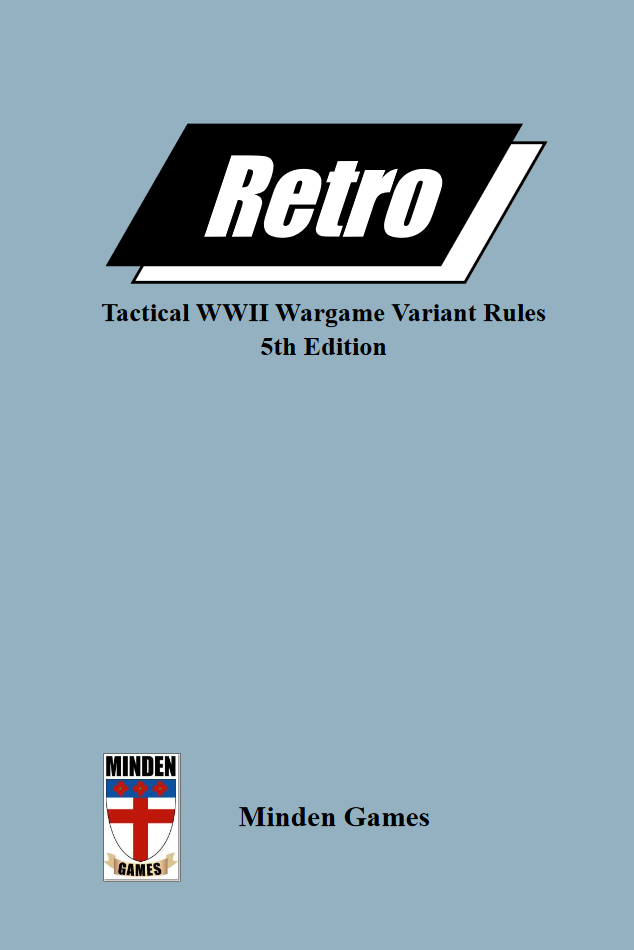 "Retro" is a set of "Tactical WWII Wargame Variant Rules", published by Minden Games. The verbiage is little evasive to get around possible legal issues, but the game is very obviously designed to be an alternate set of rules for Advanced Squad Leader. Retro itself is "just" a 62-page rulebook - the expectation is that the player owns the "host game" for Retro to be laid on top of. So the story goes, developer Gary Graber and a work colleague wanted to play Squad Leader against each other, but they couldn't be in the same room at the same time, so Graber developed this set of rules to allow one person to do their entire turn on the table, leave, and then the other person gets to do their turn. As you might expect, these rules "convert" a game of ASL into a complete IGOUGO system. The interactivity of ASL, where the "defending" player still gets to be involved during the attacker's turn such as in the case of declaring defensive fire is obviously sacrificed, but Graber is rather honest about the intent of these rules. Personally, my interest was piqued in this game precisely because, as a mostly solitaire player, eliminating the second player in this manner somewhat eases the burden of having to look over my shoulder that I'm giving one side or the other an easier time, unintentionally or otherwise. I won't spend too much time going into ASL itself, as there's a wealth of information about it already out there, including on-going Let's Plays of it elsewhere (and by much more skilled and knowledgeable folks), but I do want to go over the major revisions of Retro relative to ASL: Hesitation This is probably the biggest change of the game - during movement, whenever a unit tries to enter an open hex that is within [normal] range of a Good Order squad or MG, they need to roll a d6. On 5 or less, the unit can enter the hex normally. On a 6 or more, the unit Halts. They do not get to enter the hex that they were trying to move to, but they are still considered to have moved. Further, the Halt condition applies not just to the unit that was Halted, but to the hex that the unit was trying to move to: no other unit can move into that hex. There are some modifiers to the roll - Leadership DRMs apply, and Elite units also get a bonus. Taken together, ths introduces some interesting choices: do you cross an entire stack together, with a leader, and hope they pass the one roll? Do you combine the leader with an elite unit to guarantee your chances at passing the roll? Do you use the leader with the conscripts to help them along? Do you send them first so you can revise the rest of the turn's plans if you get an early Halt result? The idea here is that this simulates some of the effects of defensive fire: as the attacker, you will want to move into buildings, you will want to move to hexes that the enemy does not have LOS into, you will want to move into non-open hexes like grain or orchard, and so on, because all of those prevent Hesitation checks from needing to be rolled. And yet, at the same time, eventually you will have to take a chance on it: if the enemy is in a building facing a street, you might be able to avoid Hesitation checks right up until getting adjacent to the street, but actually moving to the street (in preparation for the one-hex move into melee during the Advance Phase) is ultimately going to require a Hesitation check (unless you Break the enemy first with Fire), and if you fail the Hesitation check at this crucial point, you might be delayed by an entire turn. Defensive Fire In essence, defensive fire is "automated" in Retro. After the attacker's Movement and Fire phases, the Defensive Phase is simply: every Good Order enemy unit within three hexes of the attacker's units will shoot at the attacker's units; closest first, hexes with most units first, and then randomly decided by die roll for any ties. This goes back to the idea that the attacker needs to be able to conduct the whole turn all by themselves. One might ask if restricting defensive fire to within three hexes undermines the value of long-range units. Setting aside that those units can still reach as far as they could during the attacker's Fire phase, Hesitation actually ties back into it: a 12-range MMG is not only going to apply Hesitation checks to anything within those 12 hexes that it has a LOS to, but Hesitation checks get a penalty if the unit is trying to get past an MG specifically. And there's another penalty again if movement is within half of the normal range of an enemy unit, which could be as much as 8 hexes when dealing with a 16-range HMG. Routing In keeping with the design intent, routing rules are simplified, but also are done at the instant that a squad breaks. A squad that's broken after getting fired on (whether in the Fire or the Defensive Fire phase) and is either in an open hex or adjacent to an enemy, has to move until it gets to a non-open hex. If it can't, it gets eliminated. Revised IFT Retro comes with its own Infantry Fire Table that eliminates morale checks entirely. Instead, the IFT results will simply cause units at or below a certain morale to automatically break. For example, a DR of 6 with 12 FP will cause all units with 8 morale or lower to break; a DR of 4 breaks everyone with 10 morale or lower, and a 2 or 3 eliminates everyone in the hex. As far as I can see it, this wasn't necessarily done in keeping with the whole IGOUGO design, since you can still process MCs by yourself, but instead was an attempt at streamlining (my word) the rules by cutting down on dice rolls. Comparing it to ASL's original IFT, you will need more FP to get anything done, so to speak: when rolling a 7 (the most common result on a 2d6) with a +2 DRM (wooden building, or a stone building with leadership, etc.), you need at least 12 FP to have a shot at getting an NMC, or 16 FP to get a 1MC. With Retro, you need 24 FP to get a "7" result (breaks everything with 7 morale or less) on a roll of 7. On the other hand, Retro does guarantee such breaks when you get them, where a 16 or 20 FP attack on the ASL IFT might still have the units pass the MCs anyway. There are still more changes besides, but those are the major ones, and I think that's enough preamble for us to start on our first scenario, using ASL Starter Kit #1's "Retaking Vierville". 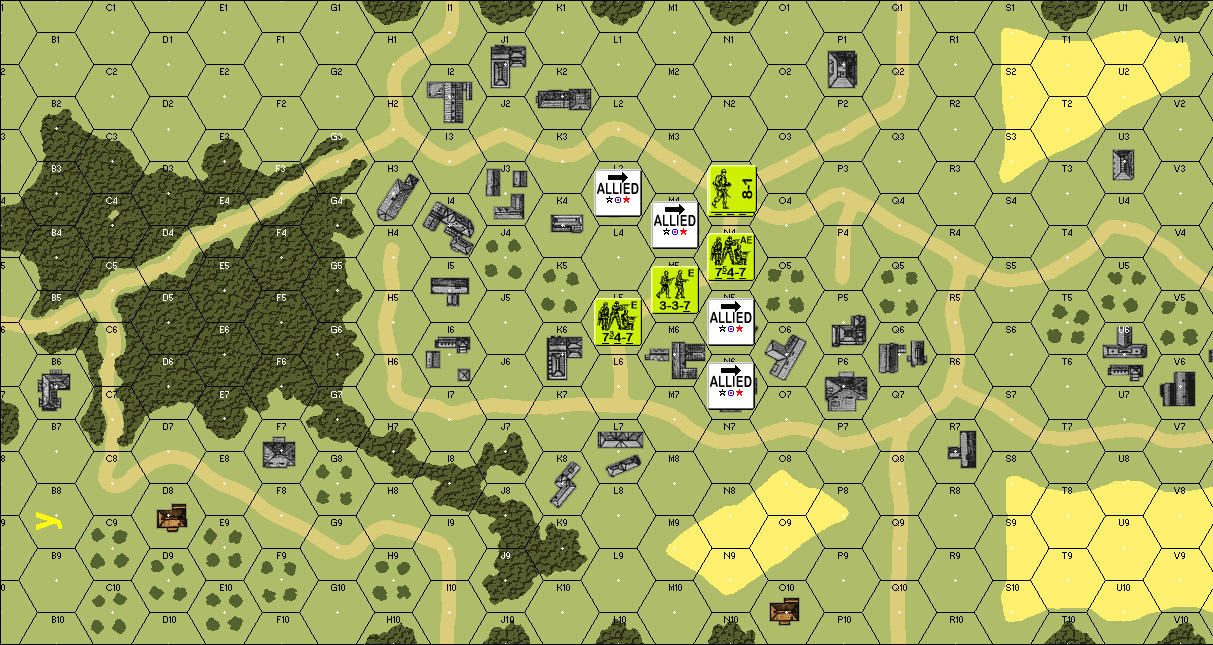 I've already done the set-up for the Americans, and the Germans, who go first, will be entering from off-map. The objective is for the Germans to enter and occupy at least one of the four objective hexes marked ALLIED, while the Americans have to make sure no Good Order German units are in those hexes at the end of five turns. German Turn 1 Rally Phase - nothing happens here, nothing to rally Movement Phase 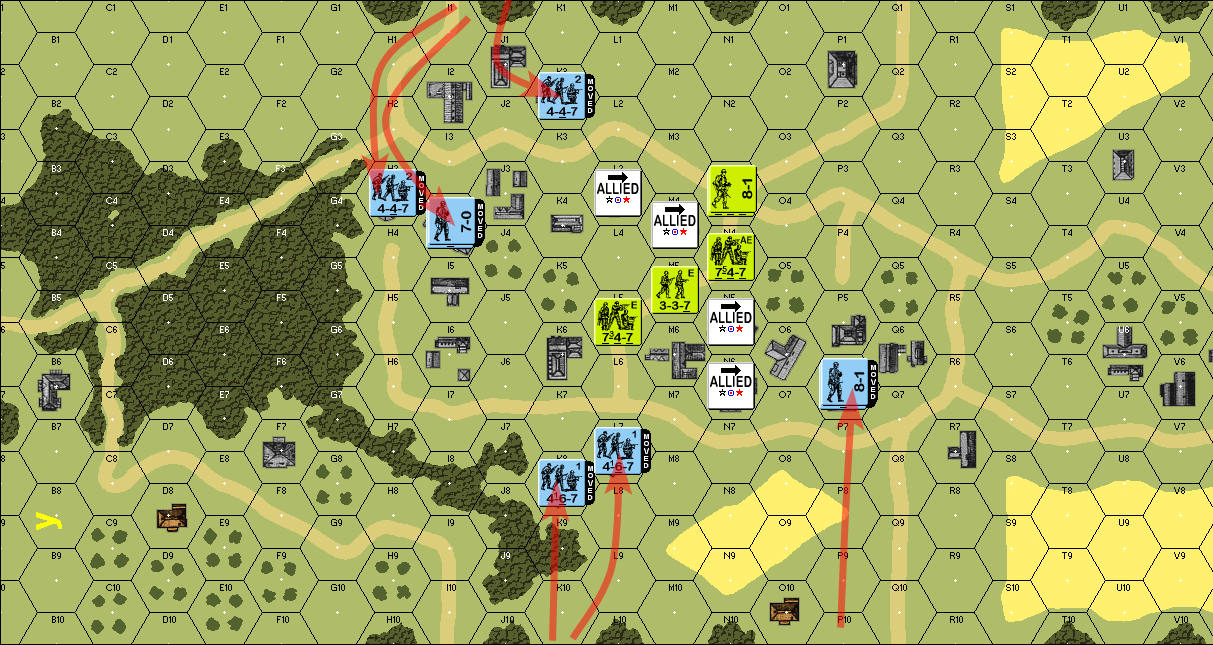 We have three squads and a leader entering from the top of the map, and another set of three squads and a leader entering from the bottom edge of the map. All of the movement done here is either out of LOS of the Americans, or out of range, so there were no Hesitation checks. For example, moving from I1 to H1 has no LOS, and while moving to H2 is within LOS of the USA 747 squad in N3, that's a range of 6, so it's outside the 747's range of 4, and no Hesitation is checked. Meanwhile, moving from K10, to L9, to L8, to L7 is within LOS and range of the 747 in L5, but since L7 is a stone building, ergo a non-open hex, no Hesitation is checked there either. Fire Phase - all units moved, so no fire is done. Defensive Fire Phase 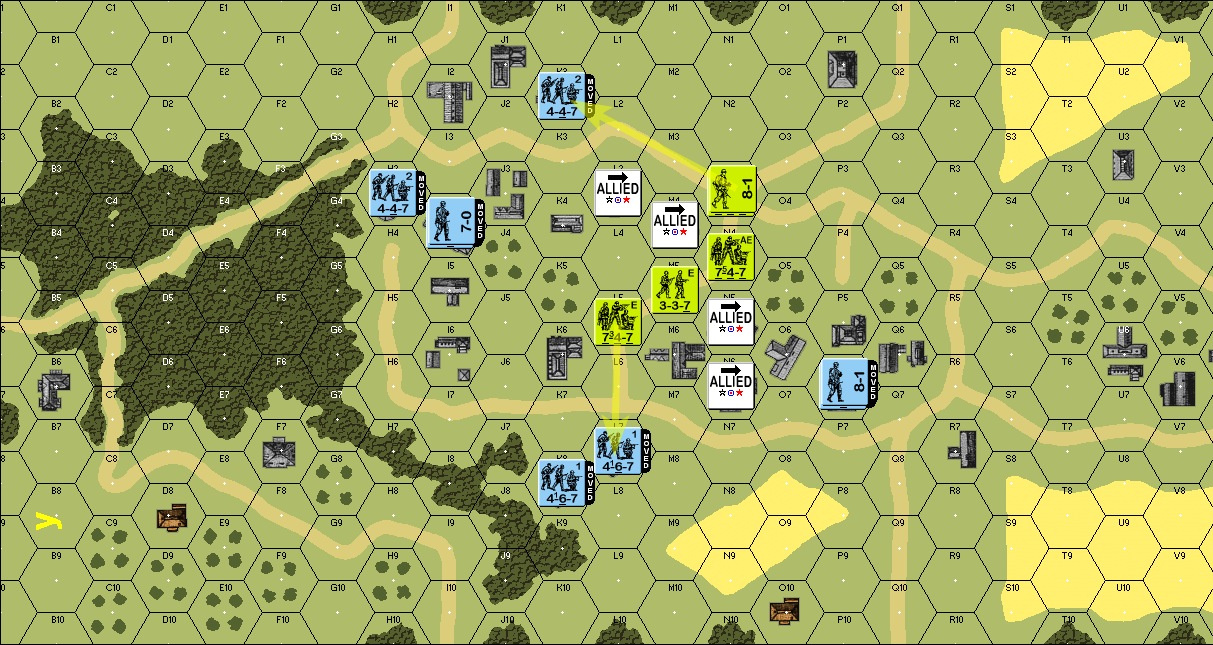 The two USA squads within 3 hexes of the two GER squads take defensive fire - rolling 8's on 7 FP attacks yields no effect on both counts. Close Combat Phase Retro abbreviates the normal ASL turn order: there's no Advancing Fire, no Rout Phase, and the Advance Phase and the Close Combat Phase are considered a single phase. 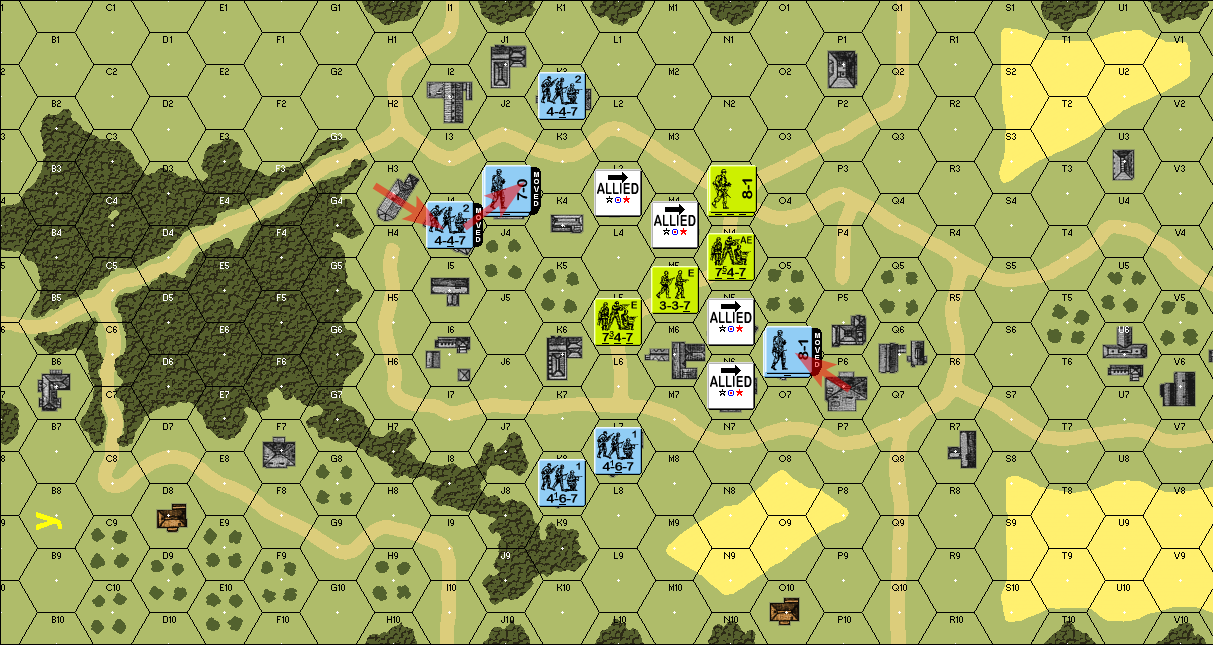 Here, the two GER squads from the top advance one hex each, as does the one squad and one leader from P6. Of note is that Retro doesn't allow an advance into open hexes that's within normal range of Good Order enemy units, so the GER 467 in L7 couldn't use the Close Combat Phase to move into M7 (or K7, or L6, or M8, for that matter). End of German Turn 1
|
|
|
|

|
| # ? Apr 28, 2024 16:41 |
|
I have the little RETRO ASL Rules booklet but I never bothered exploring it, interested to see what differences exist  Lol I scrolled up and immediately was like "Oh, its Retaking Vierville!"
|
|
|
|
American Turn 1 Rally phase - nothing to rally Movement Phase 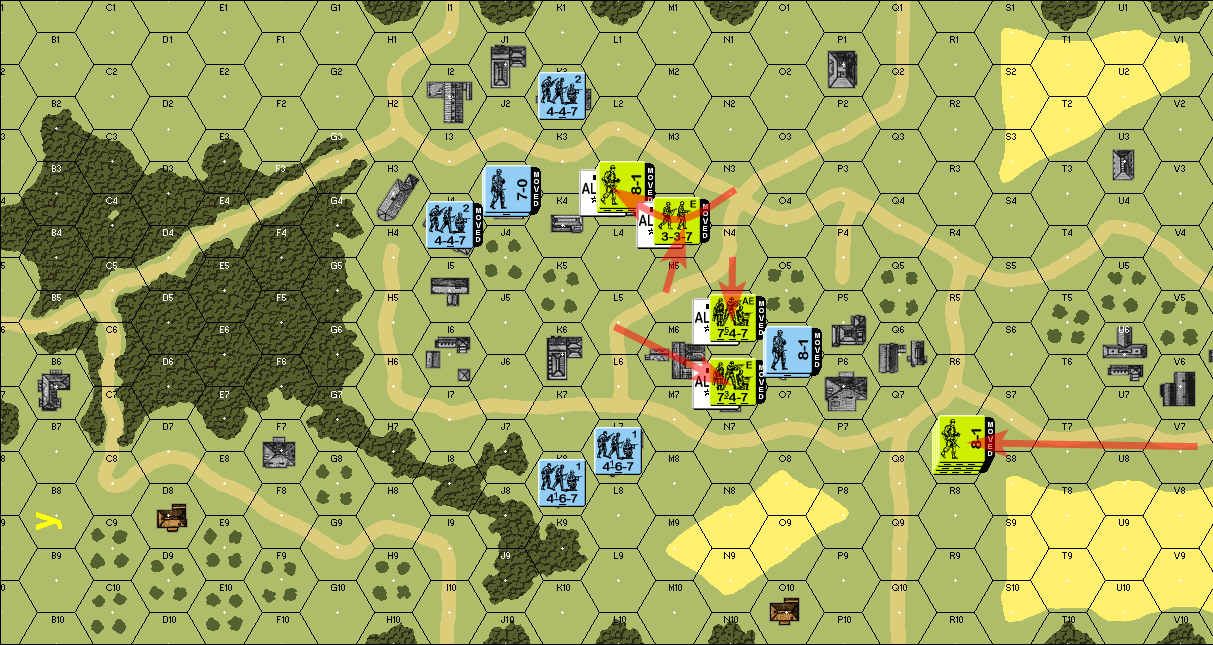 Two 747 squads move to head off the GER squad and leader at O6, while the other 747, the leader, and the half-squad move to secure the upper objective hexes. quote:Retro has a rule where infantry during the movement phase have to end their movement as soon as they move adjacent to a Good Order enemy unit. Reinforcements arrive in the form of three 747 squads and another leader coming from the right-hand edge of the map, and they move to the stone building at R7. quote:Consider the GER 467 in L7: hex S7 is still out of normal range. Hex R7 is, however, in range, but R7 being a stone building means it's non-open hex, so the USA stack can freely move into it. Since the USA squads are moving with a leader, they have 6 Movement Factors instead of the standard 4, and moving to R7 has only cost them 5 MF so far, but moving to hex Q7 would require a Hesitation roll. Fire Phase - all USA units moved, no fire. Defensive Fire Phase 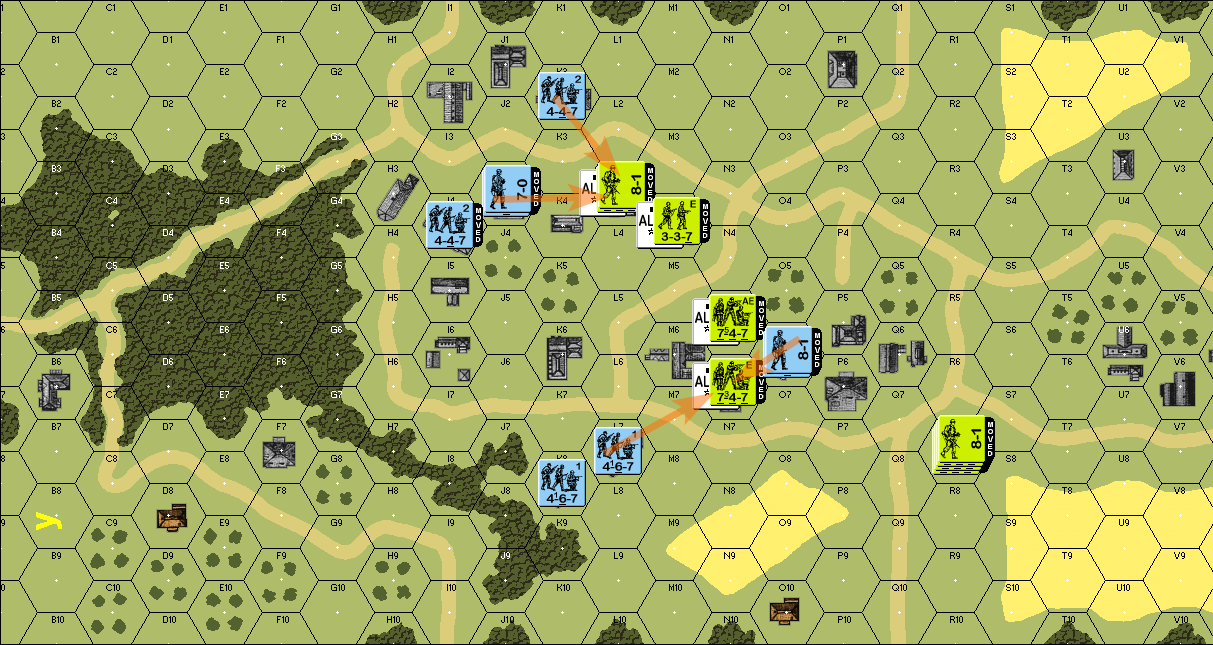 We get a sprinkling of small arms fire from the German squads, but to no effect. quote:You're going to see this a lot: if you run the rules 'by-the-book', you're going to get a lot of defensive fire that you're obliged to roll for, but feels like it's too weak to really do anything. Contrast this to regular ASL, where you tend to have much finer control over whether a shot is worth taking, though I suppose it's also true that there are still instances in ASL where you're taking 4 FP shots into a stone building just because you can and hoping for snake eyes. Close Combat Phase 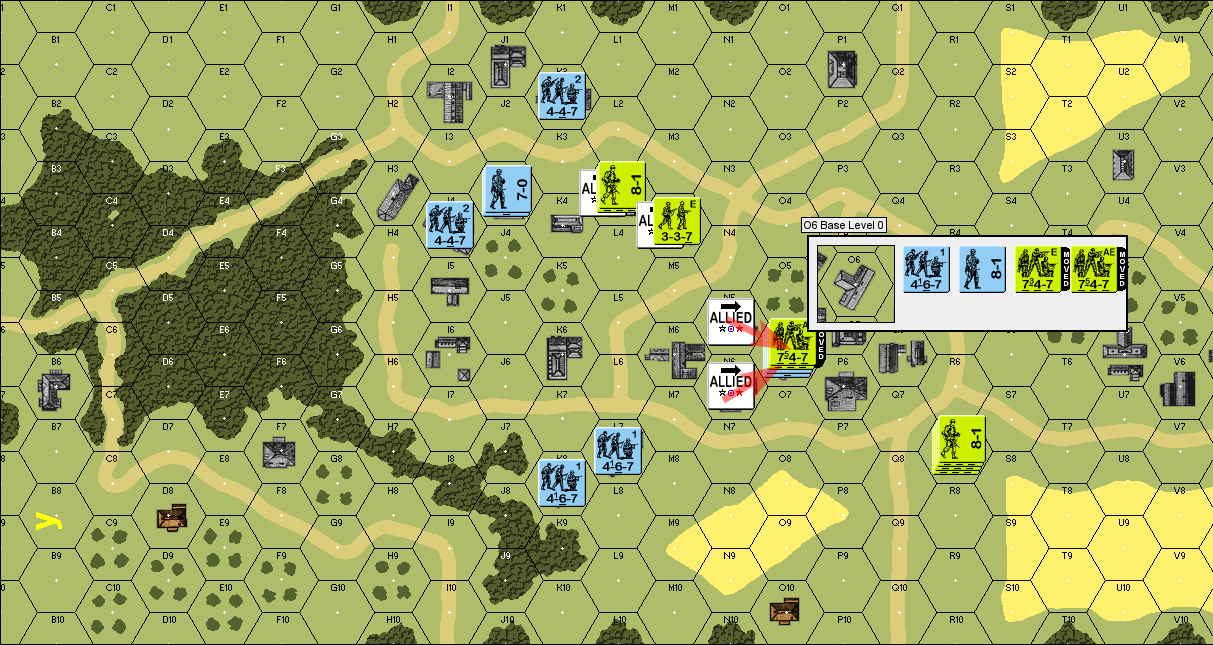 The two USA 747s move into O6 to engage the Germans in melee... quote:Close combat in O6 ... but the fight is inconclusive for now, and the men are locked in hand-to-hand fighting in the small building. quote:Retro comes with its own Close Combat results table, but to my eyes, it's result ranges are about the same with ASL's CCT. The big differences are that there's no check for Ambush, and that LMGs (but not other MGs) can add their FP value to the odds. End of American Turn 1
|
|
|
|
In Retro, do you have to roll for attacking everyone in CC or can you choose to attack a single US squad?
|
|
|
|
Jobbo_Fett posted:In Retro, do you have to roll for attacking everyone in CC or can you choose to attack a single US squad? the former. Everyone's FP is totaled and used for the odds comparison, and a successful roll in the kill range wipes out the entire enemy stack, and the rolls are considered simultaneous, so both sides can completely destroy each other.
|
|
|
|
German Turn 2 Rally Phase - nothing to rally Movement Phase 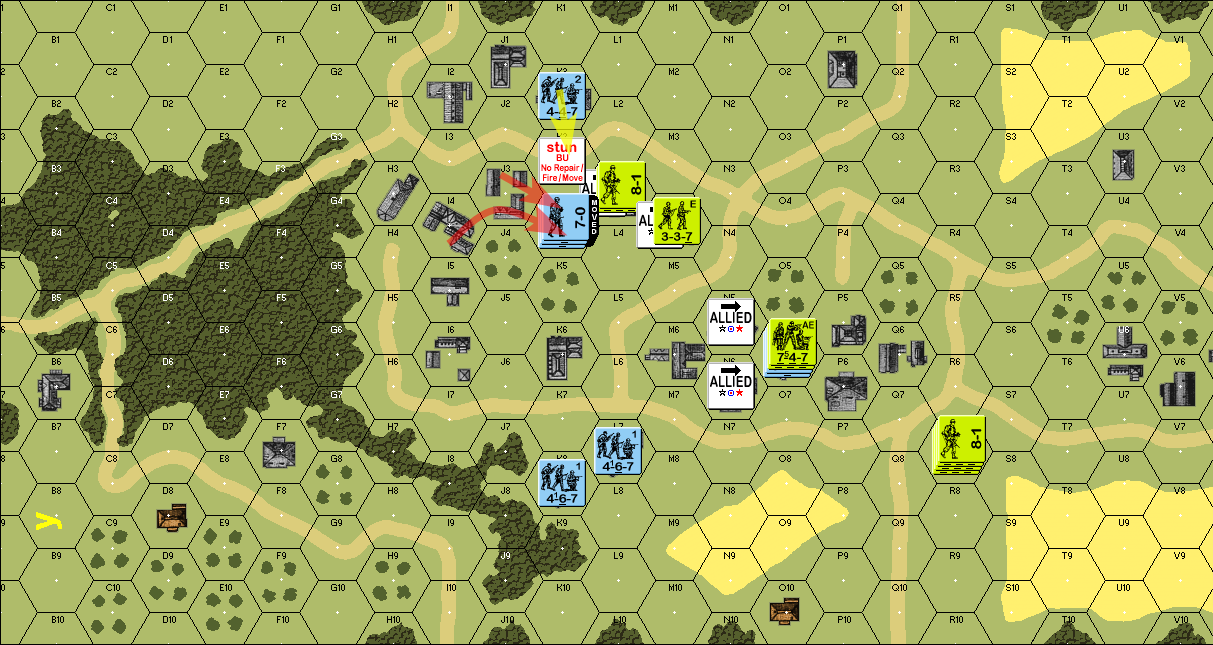 in this first part of movement, the GER 447 and the 7-0 leader in J3 moves adjacent to the L3 objective hex, and the other 447 in I4 moves two hexes to stack with them the 447 in K2 wants to move to K3, and that's going to be a Hesitation check: an open ground hex, within normal range of a Good Order enemy unit. the d6 roll is also going to have a -1 DRM since the movement is going to be within less than half the range of the USA 747 in L3. the 447 rolls a 6+1, and so it Halts. It's considered to have moved, and therefore cannot do anything else in this turn (like try to place smoke) nor can it fire during the Fire phase. It's not really necessary to place a marker on hex K3 to denote that no other unit can enter the hex, since no other unit would be in a position to try, but it's useful to remember in case it's a busier scenario, and I'm doing it here for visualization purposes. Similarly, one can/should turn on the MOVED marker that VASSAL has, to remind oneself that that unit is already considered to have moved. quote:for clarity, if there were two squads in K2, and we were moving them one at a time, and got a Halt result in K3 like we did now, a second squad still has the option to move to L2, though that would require another Hesitation checks. If we got a Halt result there also, and we still had a third squad we wanted to maneuver, they could try going L1-M2-M3, though that would need three Hesitation checks in a row. 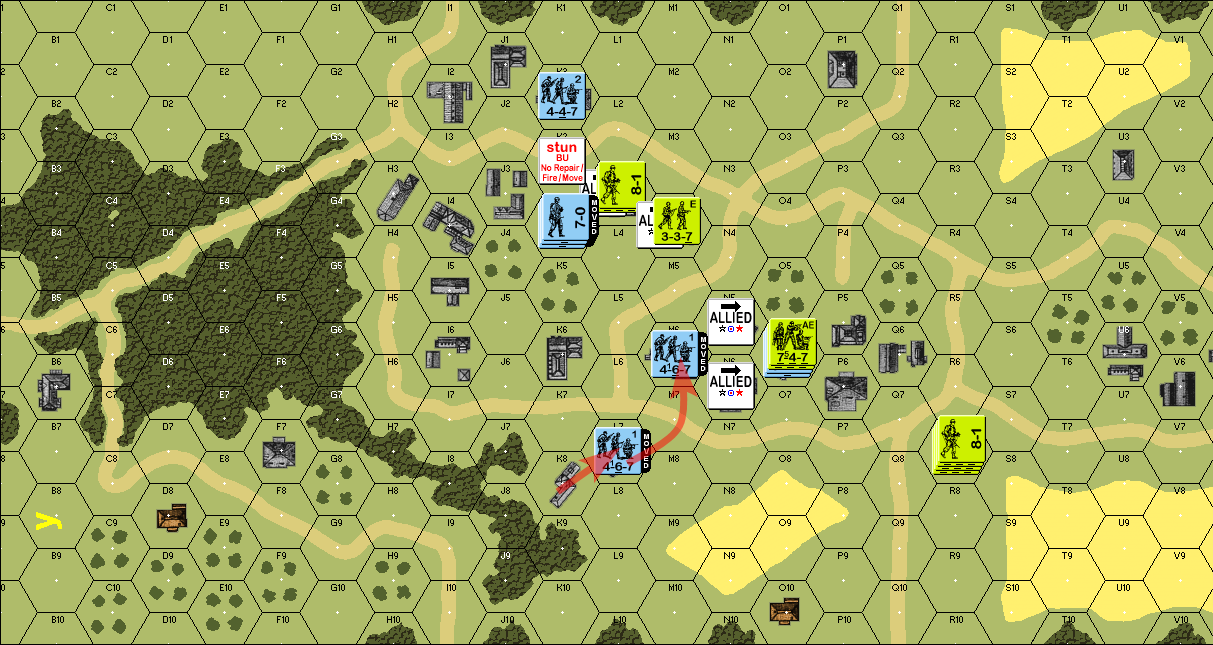 in this next movement, the 467 in L7 moves to M7, then to M6. No Hesitation check moving to M7 since nobody has LOS, and then M6 is a non-open hex. the 467 in K8 moves up one, to L7, but remains across the street 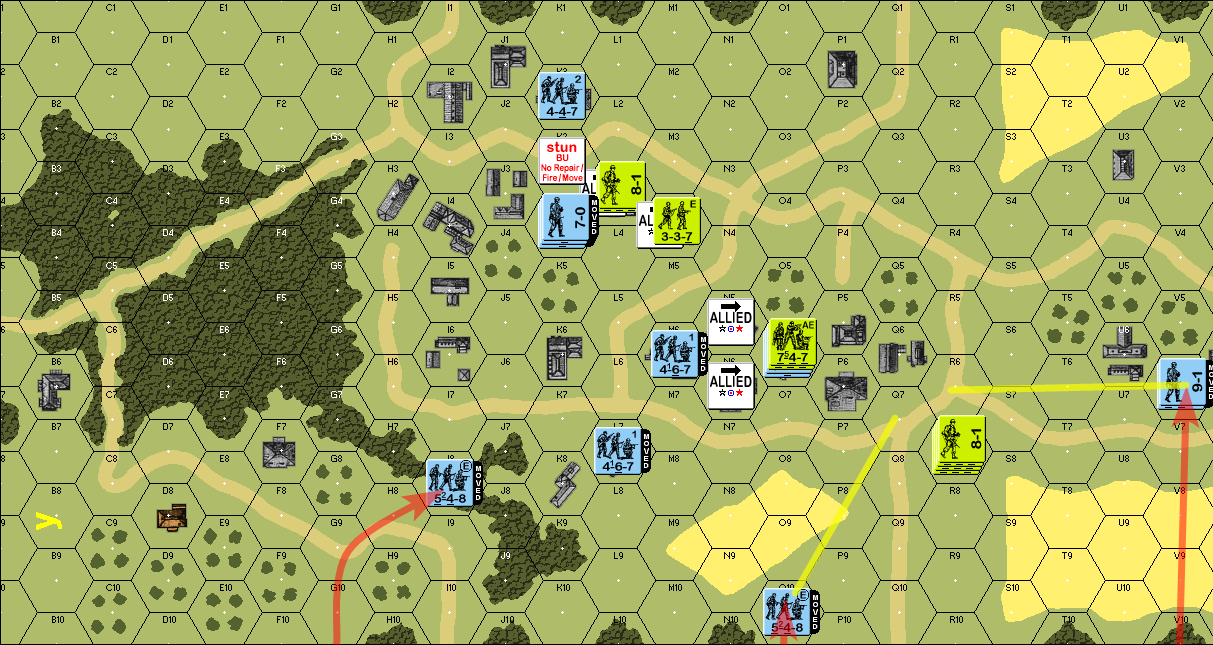 in this final bit of movement, - a 548 enters from the bottom of the map, at G10, and moves into the woodline at I8 - another 548 enters a O10, and stops there. The idea is that hex Q7 is now going to require a Hesitation check, if the stack in R7 wants to cross the street - then, a 548 and a 9-1 leader enters at V10, and moves up all the way to V6; now R6 is also covered by a potential Hesitation check. quote:when I was playing this at the time, I rolled for Hesitation checks in V9 and V8. I passed both of them, but it turns out they were unnecessary since grain is considered a non-open hex (even if it offers no TEM) Fire Phase - all units moved, no fire Defensive Fire Phase 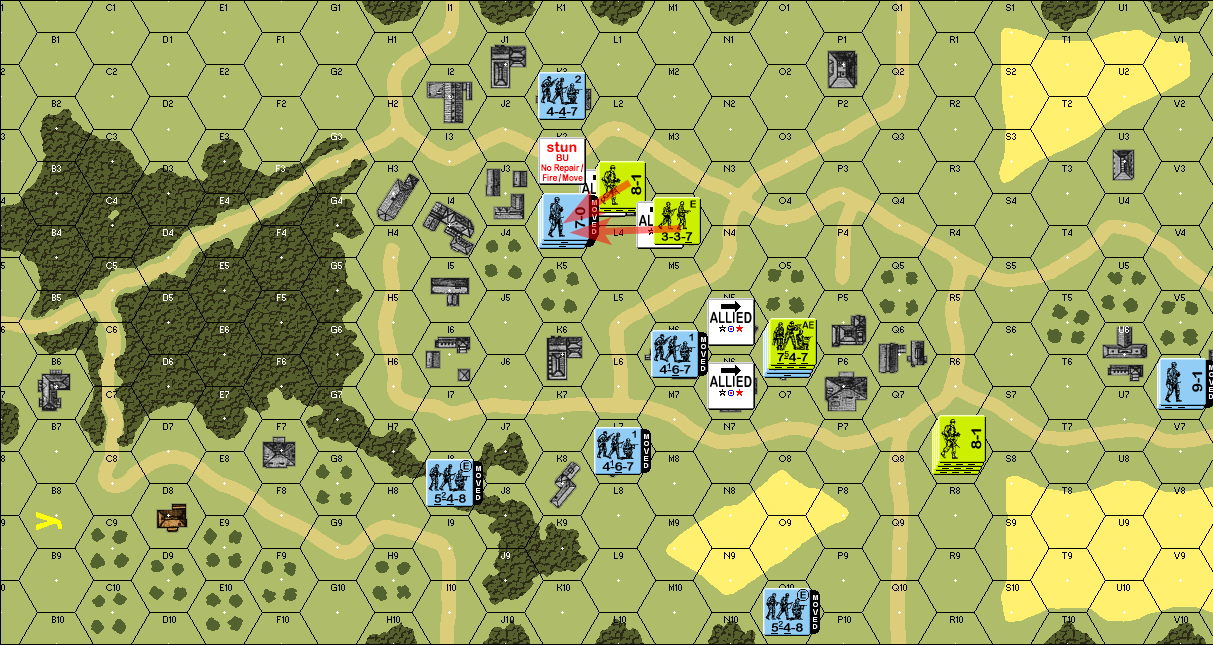 just one attack here, the stack in L3 and the half-squad in M4 shoot at the stack in K4 quote:Retro is unclear on whether you can do Fire Groups, and specifically Fire Groups during the Defensive Fire Phase, but I made an executive decision to go ahead and allow it in this case where the two hexes wouldn't be shooting anything else under the target-selection rules. the result I get from the attack is "6*", which means everything with 6 morale or less with break, but all units regardless will take an ELR check. quote:Where regular ASL uses ELR as a threshold of failure during an Morale Check, Retro does an ELR check. Take the published ELR of a scenario, where here the GER ELR is 3, and add 6 to it, giving a Retro ELR of 9. Make a DR, and if you roll over the ELR, the squad fails and gets replaced with a lower quality unit. I roll an 8 on the ELR check, which passes, so the Defensive Fire has no effect quote:I made a mistake here: only rolling for an ELR check once, when I should have done it for every unit in the stack. Oops Close Combat Phase The fight in O6 gets rolled for again, and ... quote:Close combat in O6 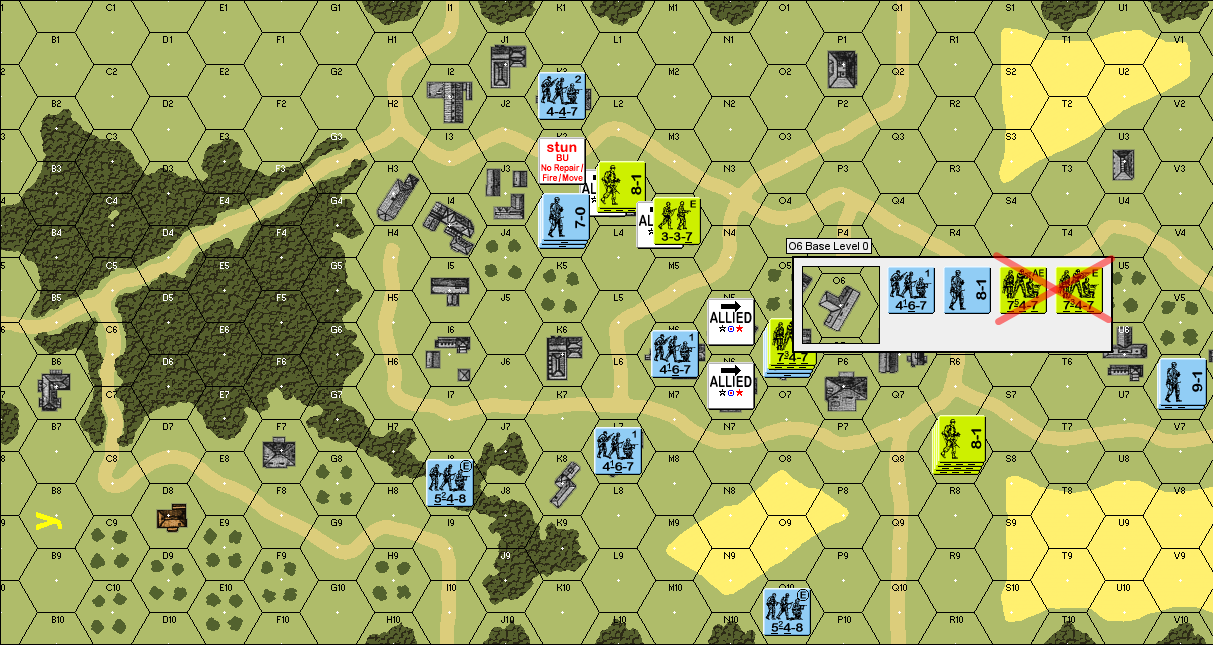 The Americans are eliminated, despite having a significant advantage in the target numbers I was so shocked by the result that I completely forgot to advance the K4 stack into L3 and try for Close Combat there. End of German Turn 2 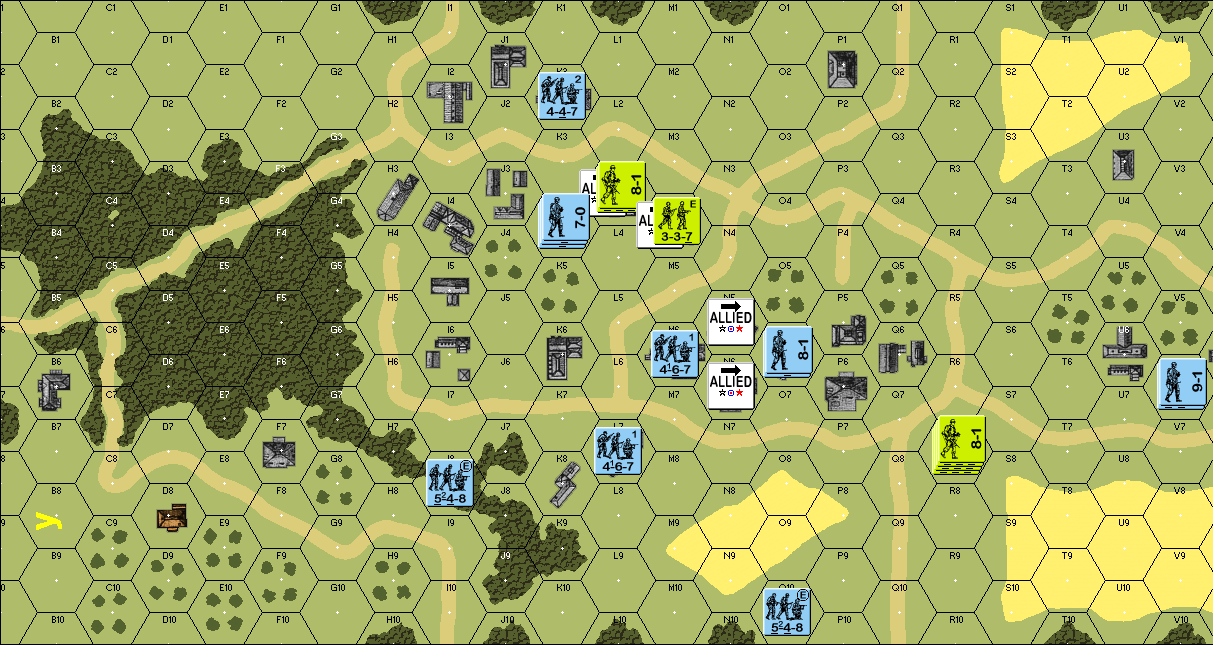
|
|
|
|
American Turn 2 Rally phase - nothing to rally Movement Phase  There are three squads and a leader in R7. One squad and one leader run across the street at Q7, passing their Hesitation check, and then a second squad runs across, also passing. The third rolls a 6 and Halts. Then, reinforcements in the form of two 747s and an 8-0 enter from the right-hand edge of the map. They start in V1 and move all the way to the orchards in Q5. They have to make Hesitation checks in R3 and Q4 due to the GER 467 in O6, but they pass both of the checks, while T2, S3, and Q5 don't require checks since they're non-open hexes. Fire Phase 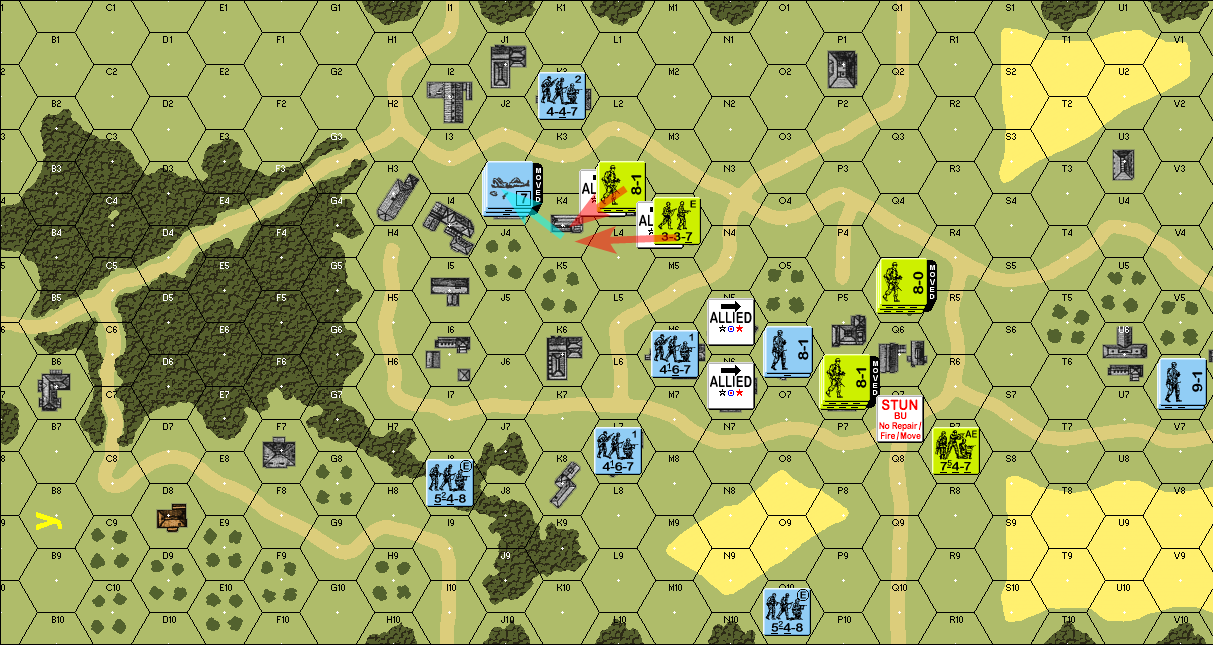 The two squads in L3 and M4 fire again on the Germans in K4, and this time they roll a result of "8". Since these GER units are all 7 morale, they break, and have to rout. quote:As I'd mentioned in the OP, routing in Retro is done the instant that a unit is broken by fire. A broken unit that's adjacent to a Good Order enemy unit, or a broken unit that's within normal range of a Good Order enemy unit while in an open hex, has to rout towards the nearest non-open hex. They have to 4 MF to do this with, and they will stop as soon as they enter their first non-open hex (that is not adjacent to a Good Order enemy). The broken units rout from K4 to J3, then stop. Defensive Fire Phase 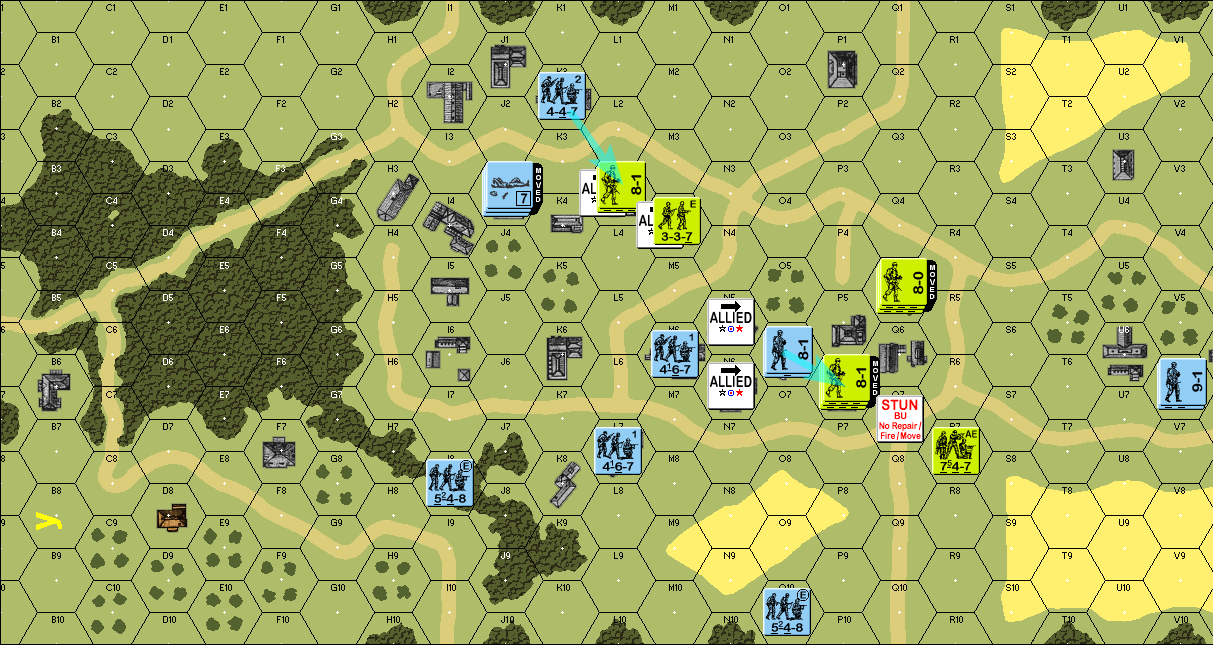 Some desultory fire from K3 and O6 towards the Americans, to no effect. Close Combat Phase 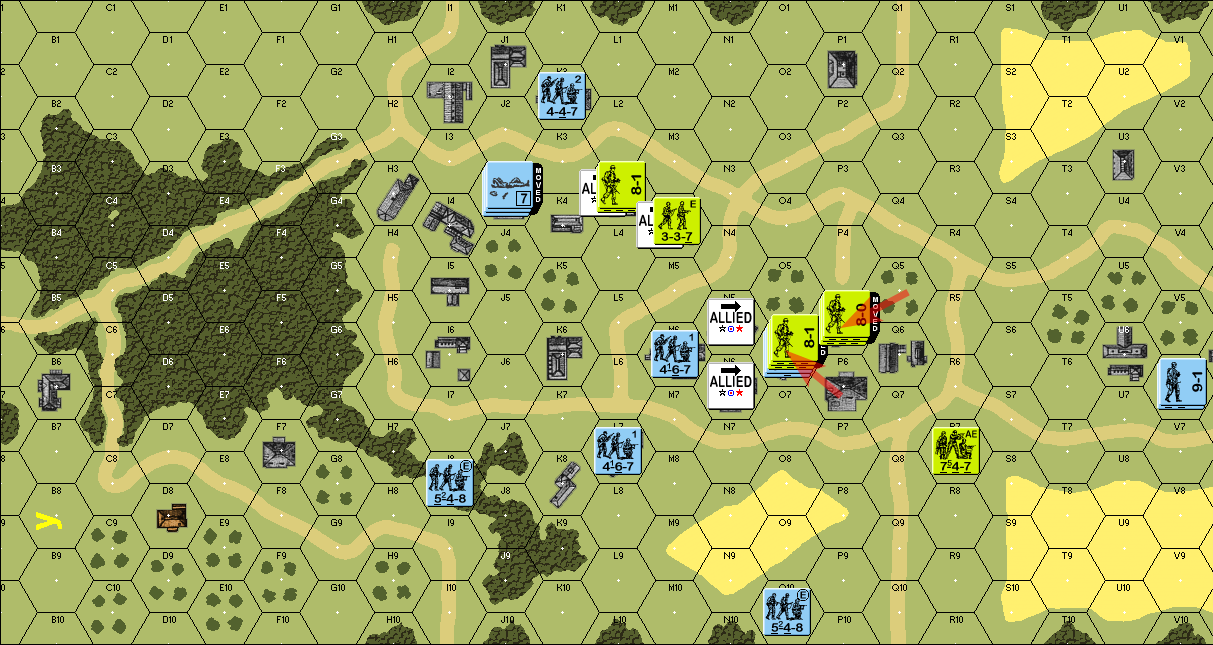 The two 747s and their leader in Q5 move to P5, while the other two 747s and their leader in P6 move to engage in Close Combat with the German stack in O6. quote:In I haven't mentioned it before, the one-hex advance you get in the Close Combat Phase cannot be used to move into non-open hexes within range/LOS of enemies, unless that movement is also going to result in close combat. So the 747 in R7 that was left behind due to a failed Hesitation check cannot use this phase to move to Q7 or R6, since it's an open hex within sight of the Germans. Close combat ensues ... quote:Close combat in O6 The entire stack is wiped out on both sides. 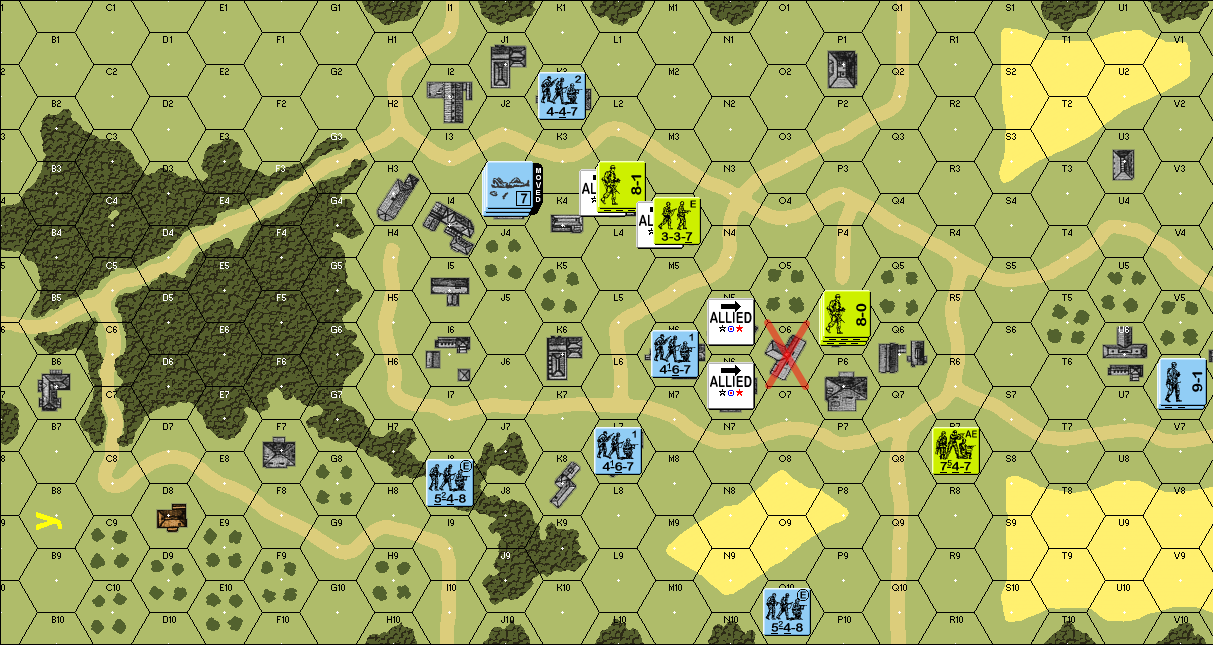 End of American Turn 2
|
|
|
|
That building is just strewn with bodies at this point.
|
|
|
|
German Turn 3 Rally Phase quote:in Retro, rallies only happen for the attacker side  in the event, the 7-0 leader and one of the 447's rallies successfully, but the other squad rolls a final DR of 8 and fails and stays broken. Movement Phase 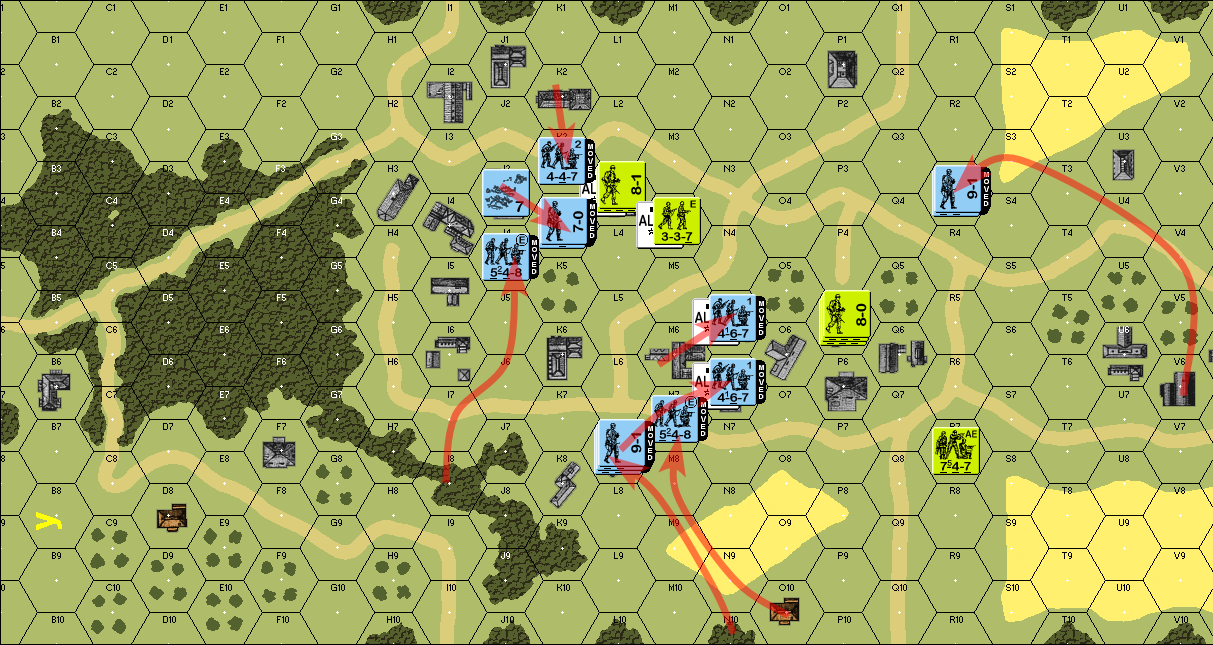 lots of activity this turn; roughly from left to right: - the just-rallied 447 and 7-0 move to K4, in preparation for another assault on the objective hex in L3 - the 447 in K3 passes its Hesitation check this time, and also gets to move adjacent to L3 - the 548 in the woods at I8 heads to the same area to pile on, passing on Hesitation check at J5 on the way - the 467 in M6 takes the objective hex in N5 - the other 467 in the building at L7 crosses the street to take the other objective hex in N6 (no Hesitation check: the 747 in R7 is out of range) - the 548 in the wooden building at O10 hustles up to M7; N9 and M9 are non-open hexes, and M8 and M7 are out of range - reinforcements arrive: two 548's and a 9-1 leader appear in N10 and run through the grain fields to take up positions at the building in L7 Fire Phase - all units moved, no fire 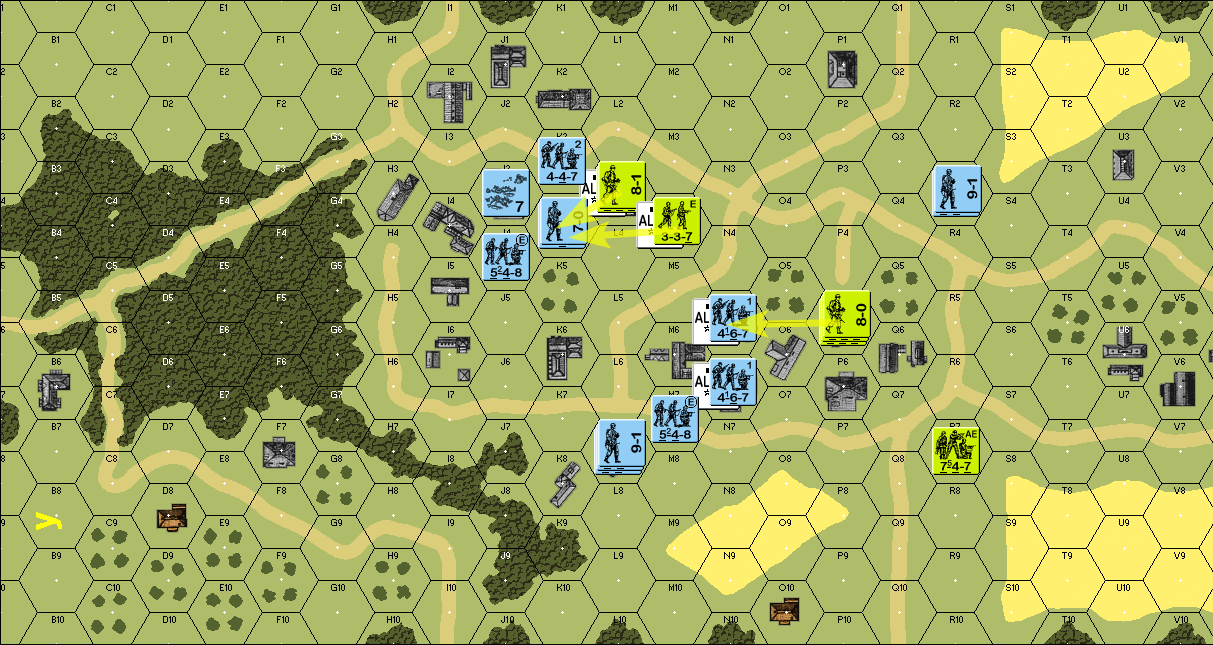 more desultory fire, to no effect quote:it certainly feels like P5 taking a shot at R3 would have been better: only a +1 DRM from shooting through the Q5 orchard rather than a +4. That's a consequence of taking direct control away to allow the attacker to process the defensive fire themselves. Close Combat Phase 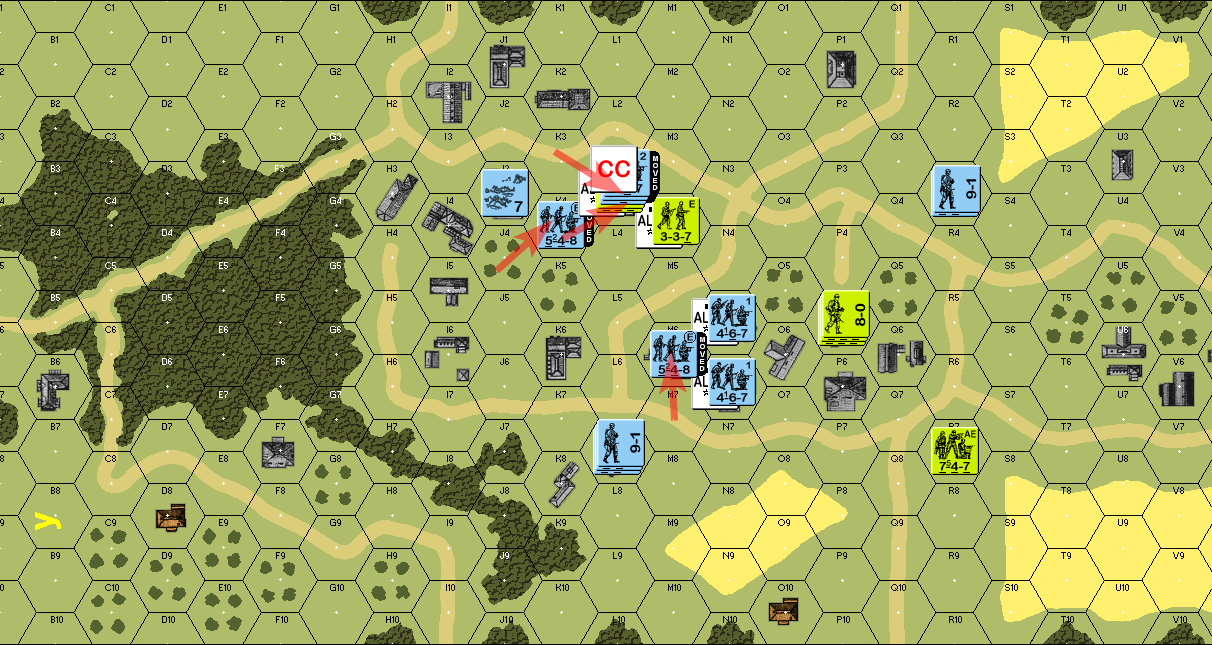 - the 548 at J4 advances to K4 - the 548 at M7 advances to M6 - two 447s and the 7-0 leader advance into the objective hex at L3 - the Close Combat is inconclusive, and both sides continue to be locked in combat End of German Turn 3
|
|
|
|
As I'd mentioned upthread, I had already finished playing through this scenario, and I'm already mid-way through the next scenario. In the process of doing so, I've been doing a lot of musing about the game, and how it relates to ASL, as such comparisons are practically impossible to avoid, given the game's pedigree. In particular, I was thinking about how easy it seemed for units here in Retro to move around, despite the existence of Hesitation checks, but I figured that perhaps I was only getting that impression because I didn't really understand the math of ASL firepower either, so I sat down and tried to think through some things. [it's entirely possible that all of this is blithely obvious and has been tackled before in the 30+ years that ASL has been in existence, but I'll be damned if I'm going to find some grainy PDF scan of an Avalon Hill magazine that beat me to the same conclusions] ___ On a roll of 2d6, the most common result is a 7: you have a 58.33% chance of getting a 7 or less (where in ASL, rolling low is good). Let's consider the American squads in "Retaking Vierville" - 7 FP each. In ASL's Infantry Fire Table... 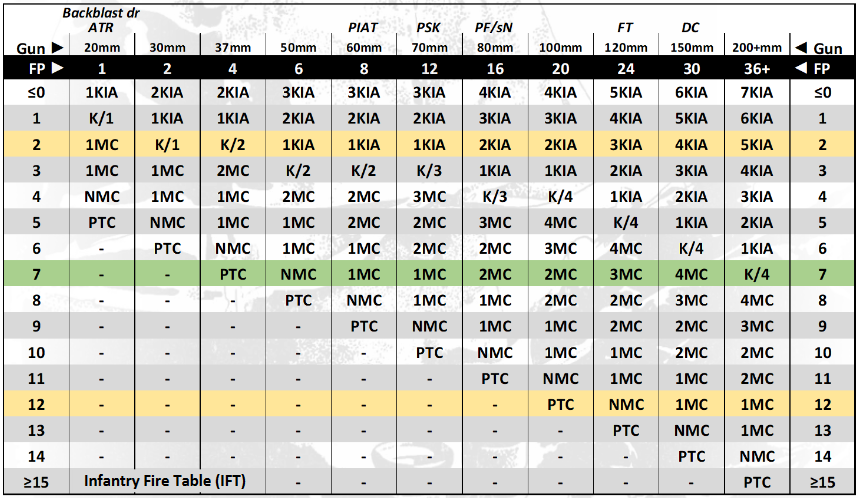 ... that 7 FP gets rounded down to the 6 FP column. If you Fire Group two of them together, you'll get 14 FP, rounded down to the 12 FP column, but that's already a big chunk of your entire force, so let's assume that we're looking at what is feasible with just a single 747 squad. Rolling a DR 7 on 6 FP results in an NMC... but a German squad with 7 morale is also going to have a 58.33% chance of passing that, which means you really only have a 24.30% chance of breaking the target: first, you'd need to roll 7 or lower on the IFT, and then they need to roll 8 or higher on the NMC. You as the shooter can't really do anything about their morale, so all you can really do is aim for a better result on the IFT. If you're rolling with a -1 DRM, then your [natural] roll of 7 becomes a 6, which results in a 1MC for the Germans. That ups your chances of breaking them to 34.02%. You don't get a 2MC on 6 FP until you hit a final die roll of 4, so I don't think it's really feasible to aim for that - getting a DRM of -3 would require something really exceptional like FFMO plus FFNAM plus a -1 leader. ___ Let's look at it from the other direction: if you have a +3 DRM on a 6 FP shot, the natural 7 gets bumped up to 10, which is a no-effect. In order to get an NMC with +3 DRM, you'd need a natural 4, which you'd only roll 16.67% of the time. Couple that with a 7 morale squad's chance of passing an NMC, and you're only looking at 6.94% chance of getting any kind of result. At +2 DRM, your chances getting a favorable result goes up to 11.57%; at +1 DRM, it goes up to 17.36% Let's reorder this: code:Well, if the target is sitting in a stone building and has no other modifiers, shooting at them probably going to be a waste of time, and you'd be better off doing anything else. On the other extreme, if the target is played in such a way that you'd have a -1 DRM to the shot, take the shot! You are never going to get anything better. Those two are the extremes, and lower DRMs are always better, but whether or not you're going to take the shot at +2 DRM is going to depend on whether you think the enemy is still going to give you anything better. If the second hex they move to is a +2 because it's passing through a Hindrance, but the third hex they move to is a +1 because the orchard isn't in the way anymore, you might want to wait for that third hex. On the other hand, if you're the German player, and you're plotting your movement, you've got to know that even a 0 DRM is going to let you get away with a lot of stuff. If you're not using Assault Move, then FFNAM applies and you're at a -1 DRM, but if you're moving into a non-open hex, then you avoid FFMO and it stays at a -1 DRM. You can use hindrances and/or TEM on top of that to keep the DRM on the positive side. ___ Having said all that, this only applies to the specific case of a 6 FP shot against a 7 morale target. An 8 morale squad (like the GER 548s that enter the scenario as reinforcements) can get away with "riskier" moves... ... or two 747s firing together on the 12 FP column can still get a 1MC on an roll of 8, so they can afford to take a +1 DRM shot and still have a reasonable chance of getting something done... ... or the Germans have much lower FP relatively at just 4, so you either have to pair up two 467s to shoot from the 8 FP column, or you take advantage of the 6 range to give yourself a much bigger radius to pick a good shot, considering that the 4 FP column wants a -1 DRM to have a shot at an NMC, or a -2 to have a shot at a 1MC... ... or we assume that even a Pin Task Check is good enough, just for the purpose of halting movement, which shifts all our assumptions one row down on the IFT... ... and then we have to factor in that an ASL unit would have multiple chances to fire, between Defensive First Fire, Subsequent First Fire/Final Fire, and Final Protective Fire. ___ The final impression I'm taking away from all this is that it seems to make a lot of sense, across both games, to really want to get to Close Combat / Hand-to-Hand, because that's the thing that has a reliable chance of eliminating entire units at a single go. EDIT: I guess another way too look at this is, the Germans in the scenario above spent most of their time in pure movement, no [Prep] Fire, and it sort of bothered me because I couldn't tell if that was "intended", but now I'm thinking that it probably is. Even if I were playing this on ASL, the Germans have 4 FP squads, and trying to assemble enough of them to get to a decent place on the IFT when shooting against the GIs in stone buildings is going to take way too many troops. I feel more confident now, having grasped the math, that it's more correct to take chances on closing up to the objective hexes as soon as possible. Any fire combat on the German side would be on the part of setting up squads with good LOS across the right-hand side of the map, to interdict American reinforcements coming in from that side and needing to cross open ground... which was coincidentally what I also did playing it through on Retro! gradenko_2000 fucked around with this message at 13:12 on Feb 15, 2024 |
|
|
|
Consider the IFT used by Retro: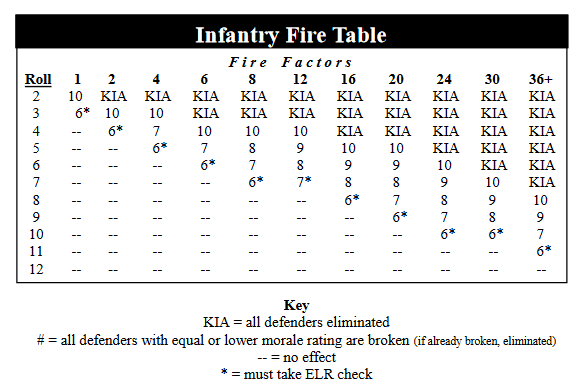 In this case, there's no morale check at all, and just getting a result of "7" means every 7 morale unit in the hex breaks automatically. Let's take the American 747 squad again, firing along the 6 FP column: getting a result of "7" means rolling a 5, which only happens 27.78% of the time, but if we think back to the ASL math we just did, an American 747 shooting a 7 morale German squad would have a 24.30% chance of both rolls ending favorably: that the Americans roll a 7 on the IFT to get a NMC, and the Germans rolling an 8 or more to fail the NMC and breaking. That's pretty close. Continuing the comparisons: - in ASL, the 747 would have a 6.94% chance of breaking a 7 morale squad sitting in a stone building for +3 DRM - in Retro, the same 747, shooting with the same +3 DRM, would need to roll a natural 2 to get a result of "7", which would happen a mere 2.78% of the time - the comparison is a bit better at a +2 DRM: an 11.57% chance to break the 7 morale target under ASL rules, versus an 8.33% chance to do the same in Retro. And so on and so forth. ___ Thinking about this situation that came up in the next scenario, War of the Rats: The Soviets are sitting in a stone building with 7 morale squads - they're sitting in a stone building, giving them a +3 TEM on the DRM - The Germans can use -1 leaders in a potential Fire Group, making the final DRM +2 according to the Retro IFT, a natural 7 is going to become a roll of 9 after the DRM, and the Germans would need 24 FP to get the "7" result on a roll of 9. The Germans have a flamethrower with 24 FP, halved to 12 since it's firing at range, and that takes care of half of the 24 FP milestone. The squad that's firing the flamethrower will itself contribute 4 FP; 8 FP to go Add in another 4 FP squad that's firing a 5 FP MMG, and the -1 leader, and Bob's your uncle : a 58.33% chance to get a "7" result, which breaks the Soviet hex Going to the 30 FP column doesn't yield any benefit, so you have to go to 36 FP to be able to get a "7" result on a roll of 10. That would require another 12 FP, which would require another two squads plus MGs minimum*, in exchange for increasing the chance of a favorable result to 72.22% The question is whether it'd be worth delving into such diminishing returns. I don't know if I really know the "correct" answer to this, but I'd like to think it's useful to gain a better understanding of the trade-offs. ___ * there's a clever bit of design here: the German LMG has 3 FP. That makes it perfect for getting a 5 FP squad up to the 8 FP column, but trying to get to 36 FP from 24 is awkward because a 4 FP squad + a 3 FP LMG = 7 FP, so you're forced to still throw two of them at the problem, with a "wastage" of 2 FP. Or you could use a 5 FP squad, and then a 4 FP squad + a 3 FP LMG... but you'd be giving up one of your elite 548's, which might be better suited for close assault since the 8 morale lets it shrug off MCs more easily. gradenko_2000 fucked around with this message at 12:54 on Feb 15, 2024 |
|
|
|
This is why you play with the IIFT and not the IFT. Also War of the Rats gives you a massive tool for the Germans - the Flamethrower. [Flamethrowers change so much about the math for your odds that you can't even combine firepower with it, iirc] As for Vierville, it teaches you that stone buildings are strong defensive tools, while also teaching you that leaders are great at trying to reduce those benefits. Whatever Retro does to prevent/reduce the chances for units to shoot during the movement phase and, apparently(?), allowing the attacker to choose where the defender shoots removes all of the IGOUGO participation and, in a full-ASL scenario, would be dogwater for scenarios that involve higher-chance snipers. And, yeah, if you can't break them via shooting, the only other option is getting into Close Combat, where US troops almost always have the advantage.
|
|
|
|
American Turn 3 Rally phase - nothing happens Movement Phase 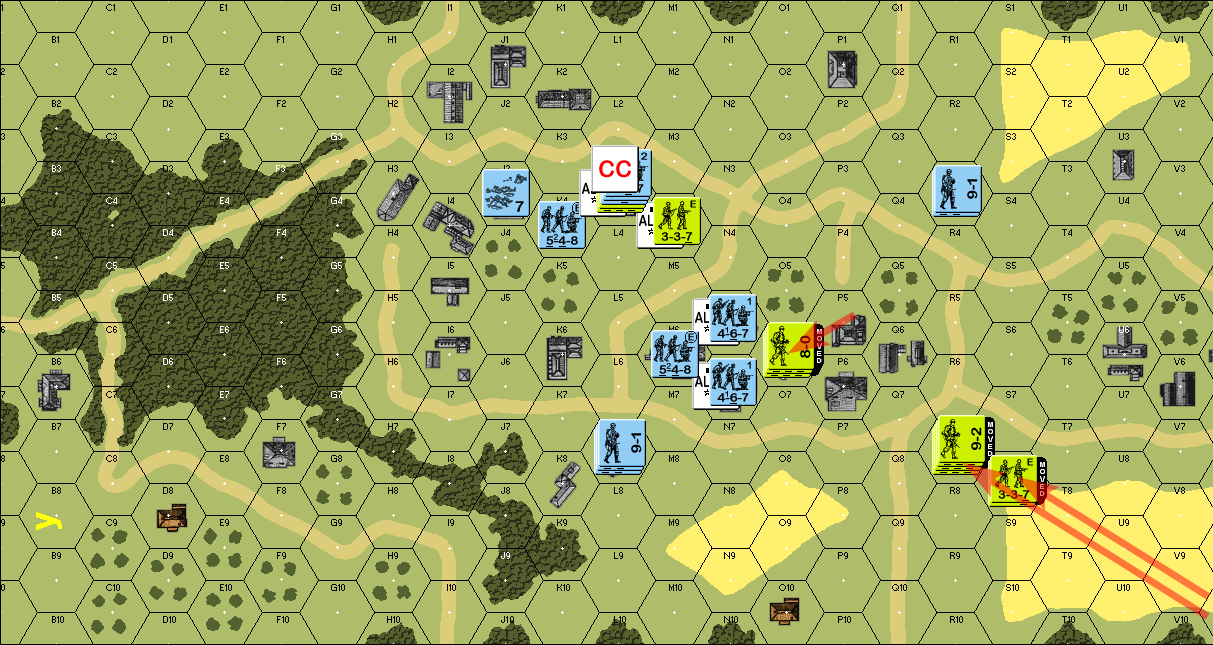 the two 747's and 8-0 at P5 move to O6, looking to retake one of the objective hexes then, reinforcements arrive, with two more 747s and a 9-2 entering from the right-hand edge of the map; they rush up to the stone building at R7, while a pair of 337 half-squads follow right behind them Fire Phase  The half-squad in M4 takes a low-hope shot at K4, while the 747 that was already in R7 since the beginning of the turn tries to hit the Germans out in the open in R3, but both roll high and nothing happens. Defensive Fire Phase 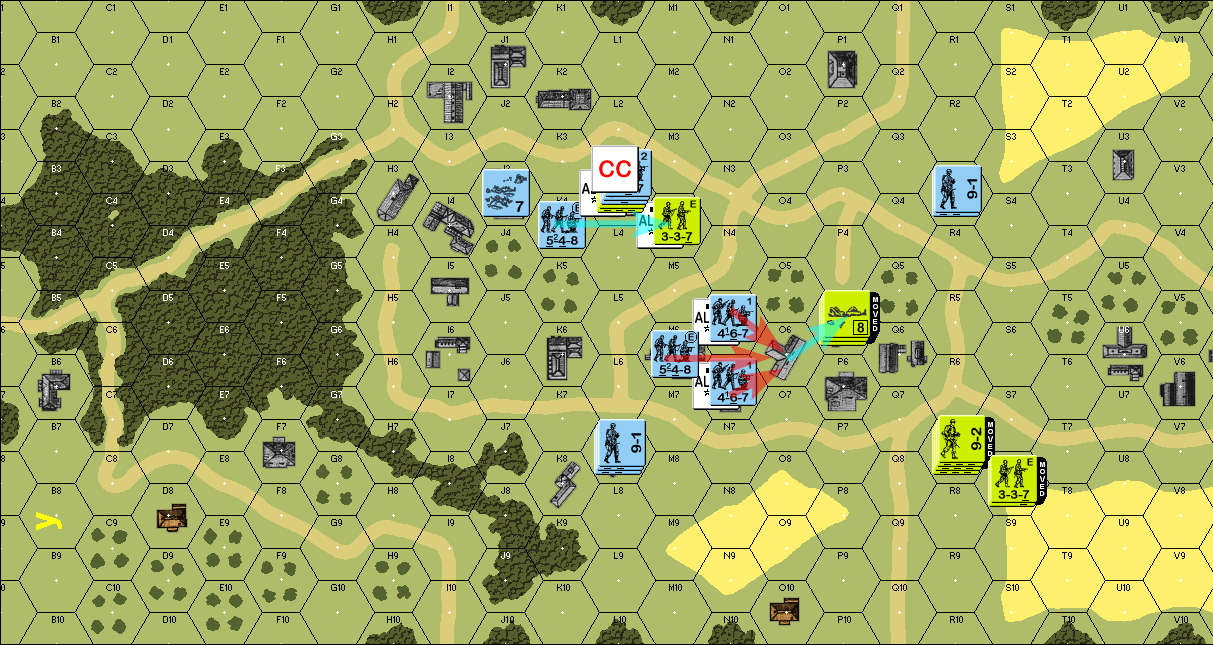 The 548 in K4 that was just shot at returns fire against the half-squad, but their attack is just as ineffective. Meanwhile, the three squads in the middle all fire on the closing Americans in O6... and they roll a natural 2. That goes up to 5 after the +3 DRM, and a Cower for rolling snake-eyes without a leader, but even after shifting one column from 12 FP to 8 FP, the result is still an "8", which breaks the whole stack and forces them to rout. Close Combat Phase 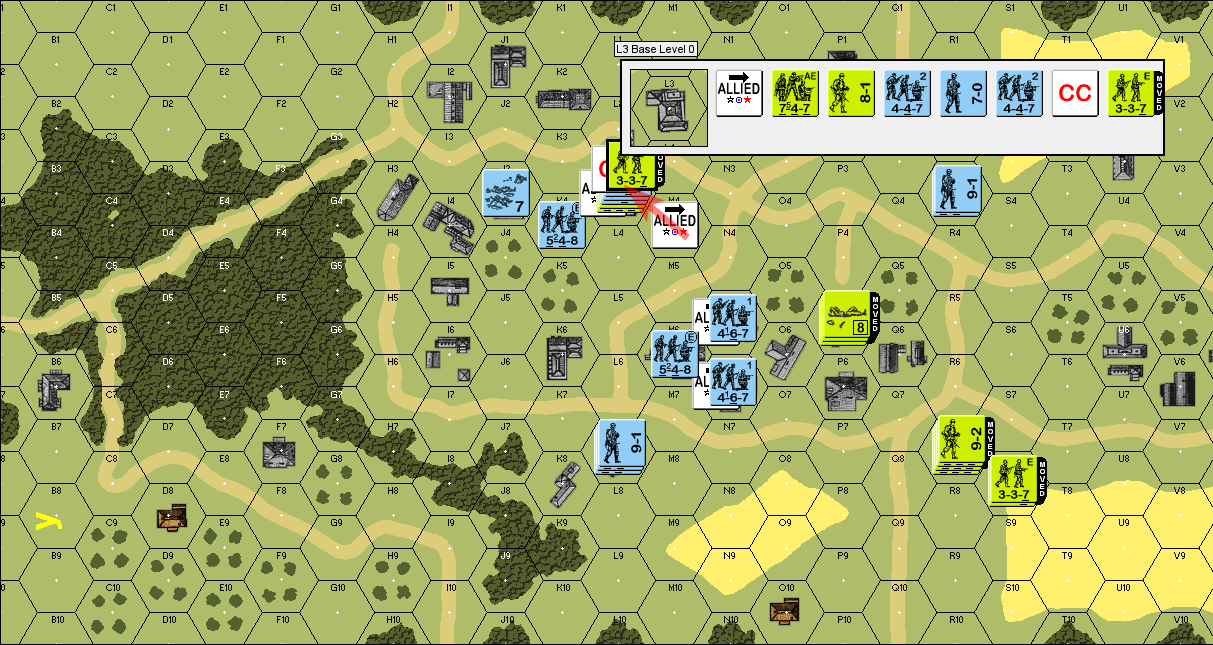 The 337 piles into the melee at L3 ... quote:Close combat in L3 it really shouldn't be surprising, because the odds were actually quite close and hardly dramatically in the Americans's favor, but the GIs rolled high and the Landsers rolled low and the latter prevailed. 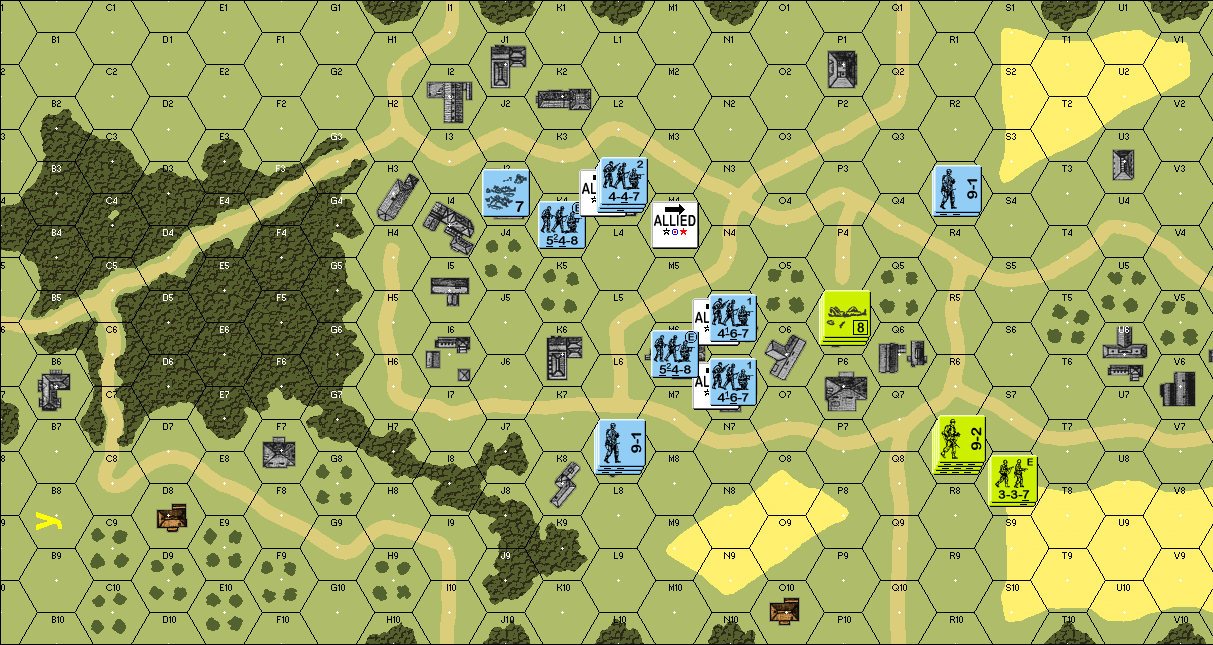 At this point, I decide to call it for the Germans. The Americans have four hexes they need to take, and they only have two turns to do it with. Even if they could make it to M4 by turn 4 with 6 MF movement plus an advance, they'd also have to precisely win the CC on the same turn, then also also precisely win another CC on turn 5 to take L3. ... which then means you'd need to capture N5 and N6 with just one squad each, and then they'd also have zero margins on winning the Close Combats for them against Germans that are guaranteed to outnumber them in least one of the hexes.
|
|
|
|
For our second scenario, we'll be playing "War of the Rats", an engagement between German and Soviet forces, set in the ruins of Stalingrad, circa September 1942.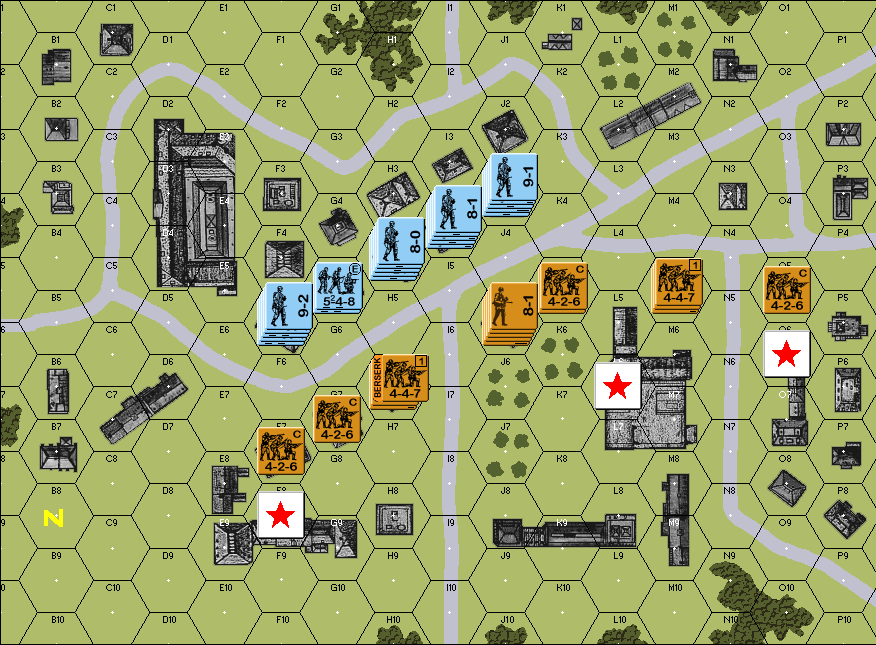 The goal of the Germans is to take the three buildings marked with red stars, while the Soviets have to stop them. The Soviets deployed first, and their thinking was to give the MMG in J5 a nice wide field of fire, with the rest of the troops dispersed across the front. The Germans deployed second, and their plan was to go heavy on the left-hand side of the map, and sweep from left to right. German Turn 1 Rally phase - nothing happens Movement phase 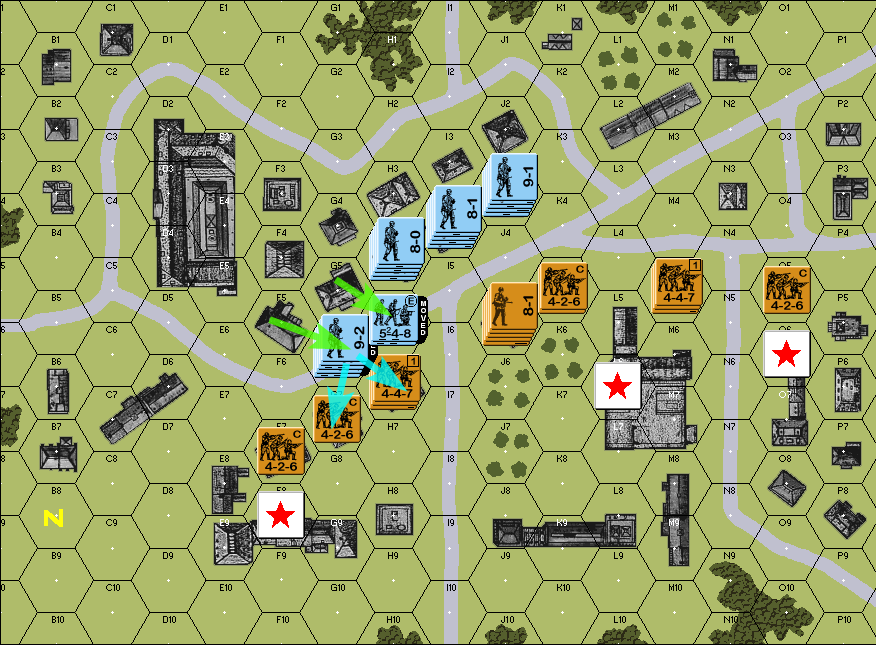 From hex F5, two 548 squads and their 9-2 leader move to the street; they make a Hesitation check, but pass it. Actually, it would have been impossible for them to fail: -2 DRM from the leader -1 DRM from being elite +1 DRM from being within range of an MG +1 DRM from being within less-than-half normal range of gunfire total of -1 DRM, so at a natural 6, it would have still been a modified 5, which passes The teal arrows denote that they are going to attempt to place Demolition Charges on those two hexes. Based on my interpretation of how Retro and ASL can fit together, if the two squads are still in Good Order after the Defensive Fire phase, then the Charges will be placed properly, and then they will explode as a 30 FP attack at the very start of the Close Combat phase (as the closest analogue to ASL's Advance phase). meanwhile, two 548 squads in G5 move to H5, passing a Hesitation check to do so. Fire Phase 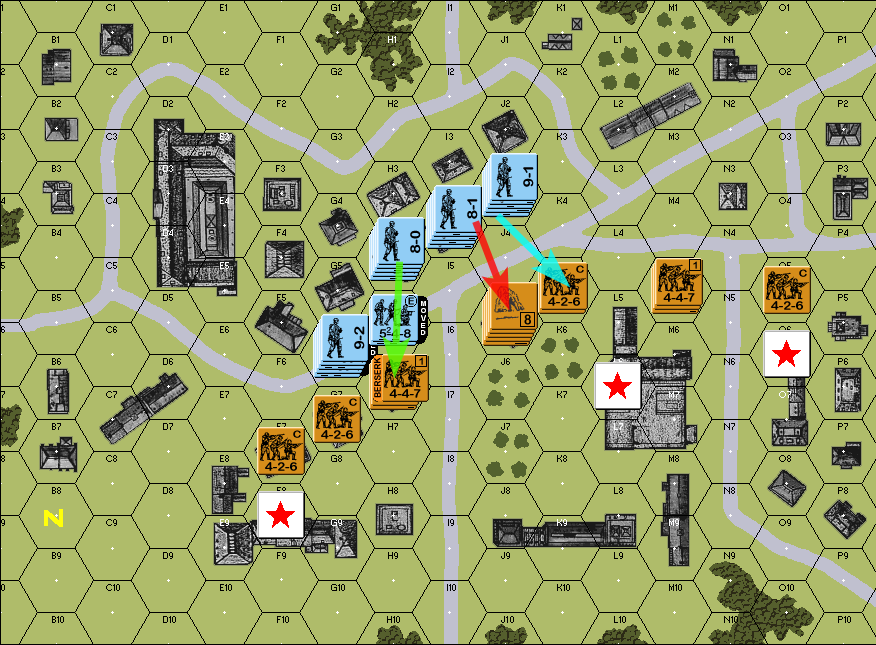 - green: the stack in H4, which includes a Flamethrower, fires a 24 FP attack against the Soviets in H6, which results in an ELR check; the Soviets roll a 3, which is not only a pass, but also makes one unit go Berserk. Random selection assigns the Berserk to the 447 squad. quote:Berserk: squad gets 8 MF, and during its Movement Phase, must move towards an enemy, and attempt to enter Close Combat with it. If it survives Close Combat, the Berserk status is lost. - red: the two stacks in I4 and J3 form a 30 FP fire group and tries to take out the Soviet MMG team in J5. They succeed and break the entire stack. The Soviets are already in a non-open hex, and not adjacent to an enemy, so no rout is needed. - teal: the fire group's MGs get Rate-of-Fire and shift to attack K5, but to no effect. Defensive Fire Phase 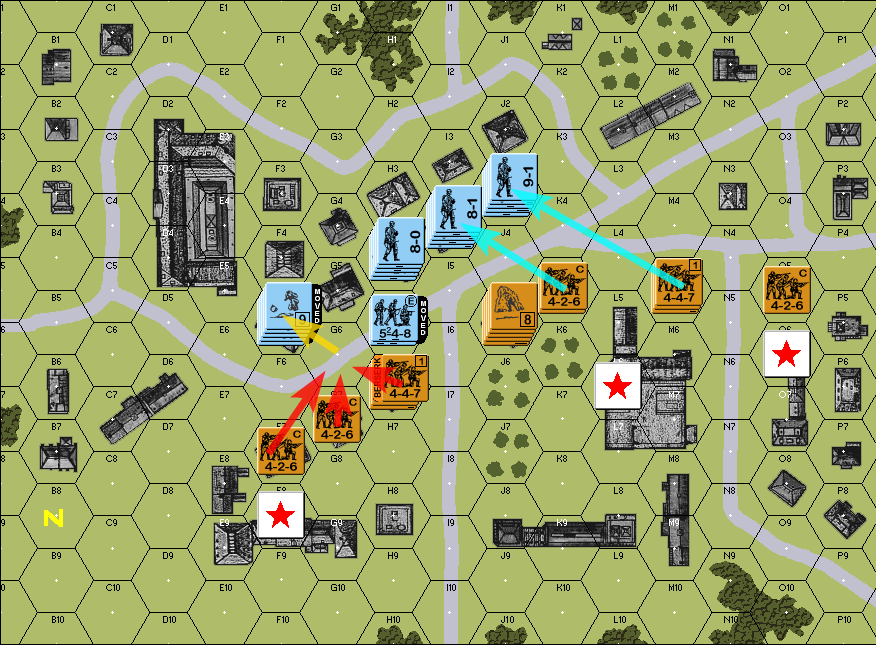 - red: the Soviets on the left flank form a fire group and blast the Germans trying to plant Demo Charges. They break the stack, foiling the plant attempt, and force them to rout to F5 - teal: the rest of the defensive fire this turn is of no effect Close Combat Phase  The two 548s in H5 advance H6 and engage in close combat. The rolls are inconclusive, and the two groups are locked together. End of German Turn 1
|
|
|
|
DCs explode in the Advanced Fire Phase for ASL. Also that Flamethrower has a range of 2!?
|
|
|
|
I goofed on the flamethrower because I was correctly halving the FP for a range-two attack but I was counting it as part of a fire group, which it shouldn't be able to do as for the DCs, Retro doesn't have an Advance Fire phase: the Close Combat phase is both the "move one hex" and "resolve CC" phase in one, so I figured "start of CC, before any movement" would be close enough
|
|
|
|
gradenko_2000 posted:I goofed on the flamethrower because I was correctly halving the FP for a range-two attack but I was counting it as part of a fire group, which it shouldn't be able to do Yeah, which changes the math on how the shots go out - or at least moreso in ASL because of the FT's properties. Also gross, losing an entire phase in Retro  Bummer that you have to survive the entire defensive fire phase, but I guess that's the trade off when you don't shoot in movement. Bummer that you have to survive the entire defensive fire phase, but I guess that's the trade off when you don't shoot in movement.
|
|
|
|
Soviet Turn 1 Rally Phase 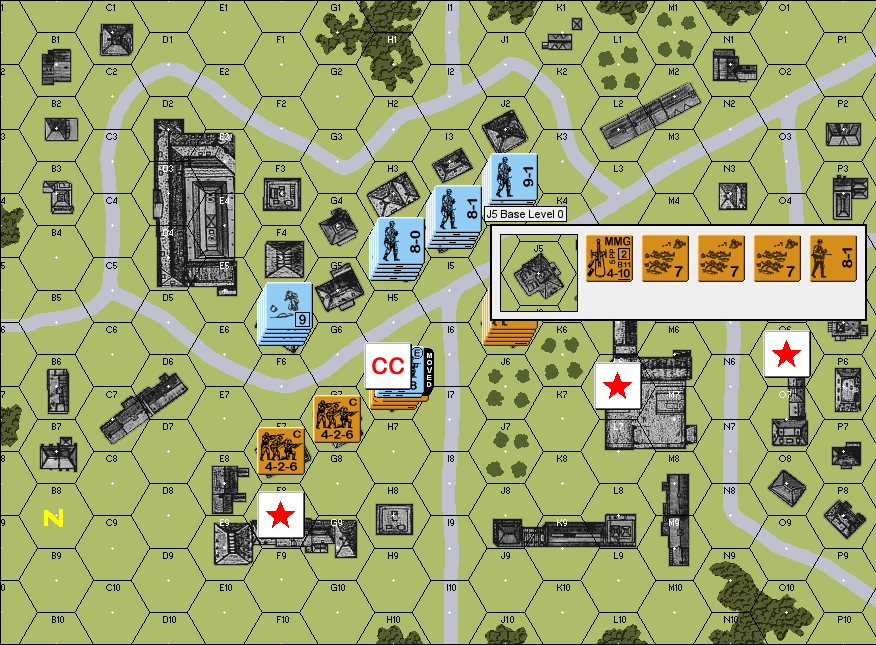 in hex J5, the leader rallies, but the three other squads do not. quote:in Retro, leaders are not affected by Desperation Morale (which, to recap, is a +2 DRM in Retro, and always applies as long as the unit is within LOS of a Good Order enemy). There's also a -1 DRM for rallying in a woods, building, trench or pillbox hex, so the leader's Rally DRM is -1 overall. They rolled a 9, modified to 8, which passes Movement Phase 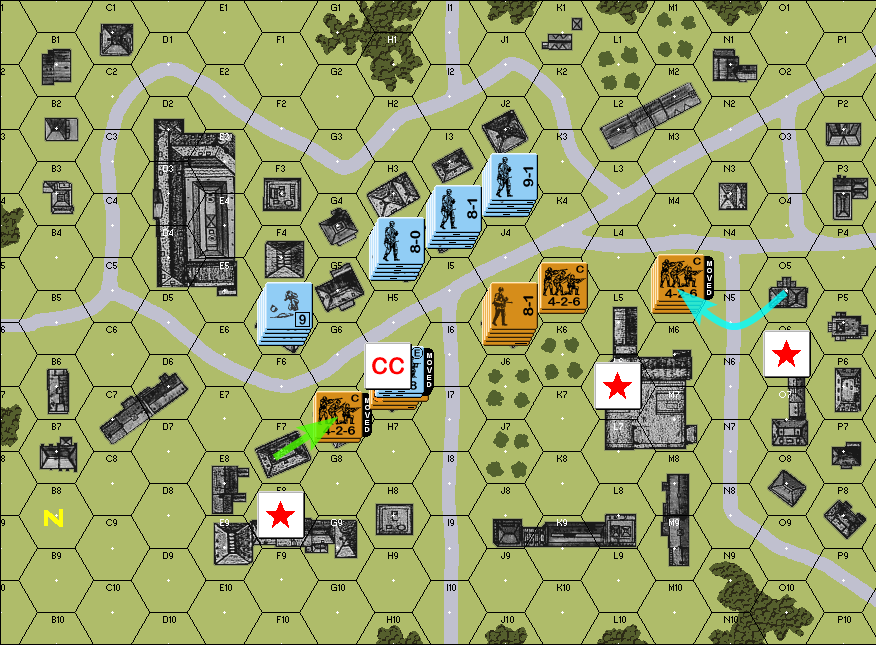 - green: the 426 in F7 moves to G7, with the intent of piling onto the on-going Close Combat - teal: the 426 in O5 moves to reinforce the squads across the street Fire Phase the Soviets fire against the Germans holed up in J3, but to no effect. Skipping a screenshot since it wouldn't show anything Defensive Fire Phase 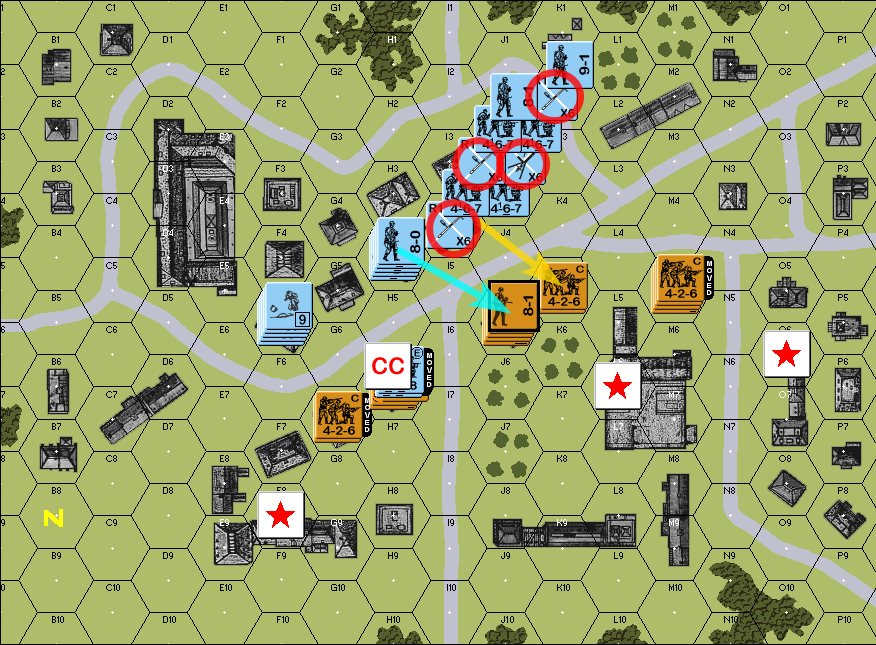 - teal: the German stack in H4 fires against the Soviets across the street. The result is an ELR check that the Soviets pass with a 3, which is supposed to make one squad go Berserk, but all the squads are broken anyway, so nothing happens. quote:I'm not actually sure if a Berserk result can cause a broken squad to rally, but I decided to leave it well enough alone - yellow: the two German stacks form a 24 FP fire group, but they roll boxcars, which not only makes the shots miss completely, but also breaks all four of their machine guns. A lucky break for the Soviets. Close Combat Phase 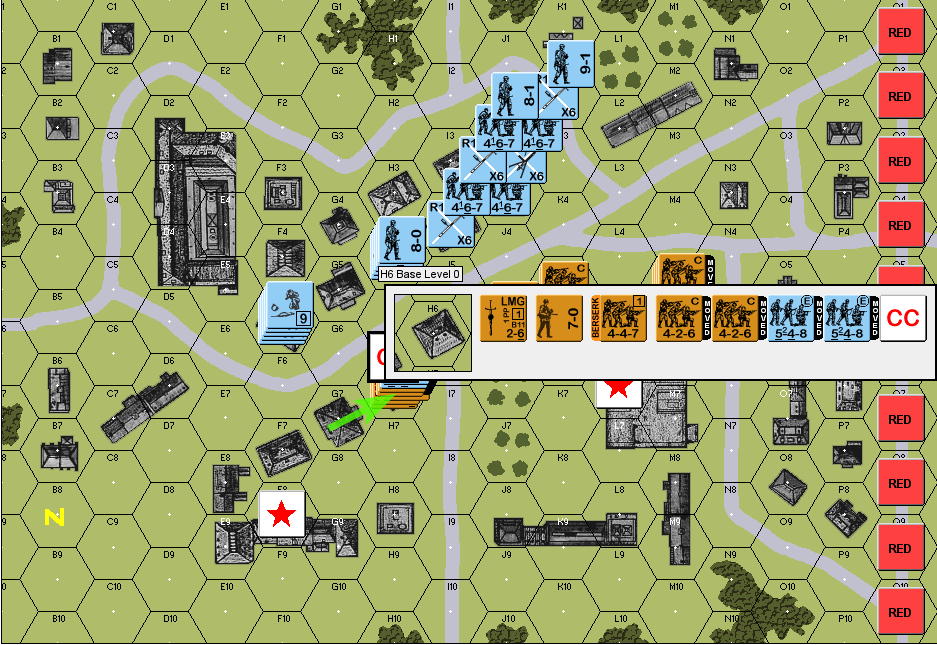 the two 426 squads in G7 join the Close Combat already on-going, but despite the Soviets shifting the odds to 3:2, both they and the Germans roll high and the melee remains inconclusive. (the RED counters are just a marker for me to denote the limits of the playable area) End of Soviet Turn 1
|
|
|
|
I'm no ASL expert, but I think it is possible to rally a broken unit by firing at it and making it berserk, since IIRC Jobbo or someone else mentioned it as a weird quirk in the Board-wargaming thread in TG.
|
|
|
|
A unit being shot at that triggers Heat of Battle can indeed go from broken to Berserk. A leader can go through the same, and will force all units stacked with him that have the same, or lower, morale to take checks to see if they also go berserk. Also SW malfunctions is random selection, same as cowering.
|
|
|
|
Also also you can crop the board in VASL. You can also opt to select a "new map" if a game is already in progress, select the same map youre on, and crop it while in play.
|
|
|
|
German Turn 2 Rally Phase 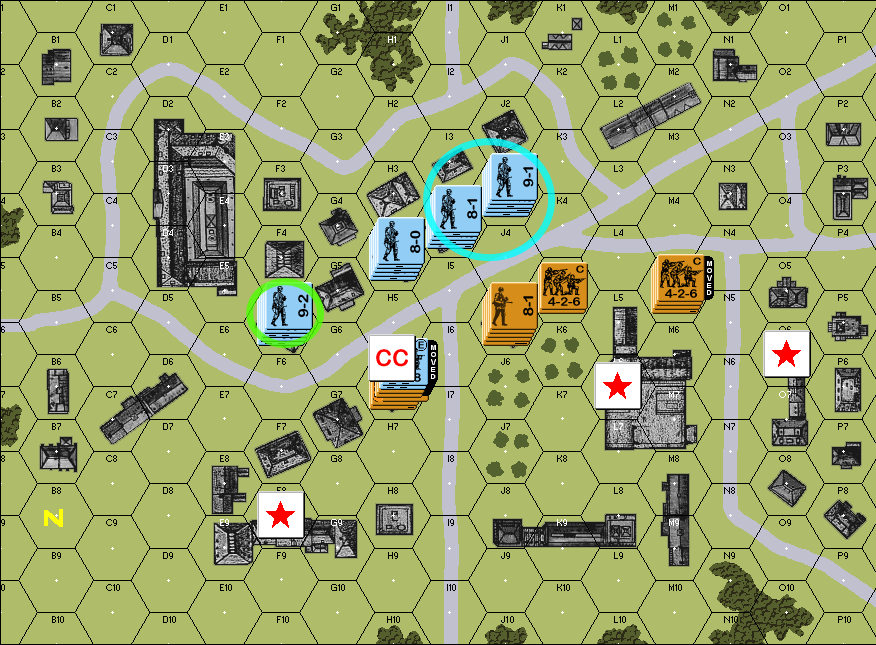 The stack of two 548s and a 9-2 in F5 all rally successfully. And in the I4/J3 Fire Group, one LMG and one MMG are repaired, while the other two remain broken quote:Taking note of the feedback that MG malfunctions are supposed to be randomly selected, for future reference. Movement Phase 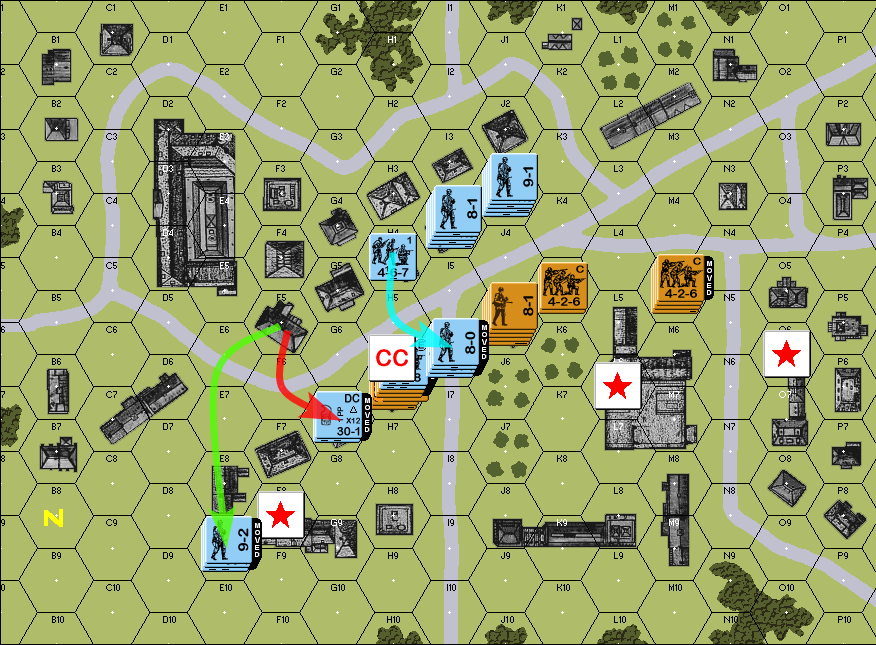 - green: a 548 squad and the 9-2 leader runs to take the left-hand objective building - red: the other 548 positions itself to assist in the melee in H6 - teal: two 467s, one of them with the flamethrower, and the 8-0 leader, move from H4 to H5, then to I6. The H5 move is not a Hesitation check, because the Soviet squads in J5 are broken, and H5 is beyond the normal 2 range of the 426s in K5. Fire Phase Defensive Fire Phase 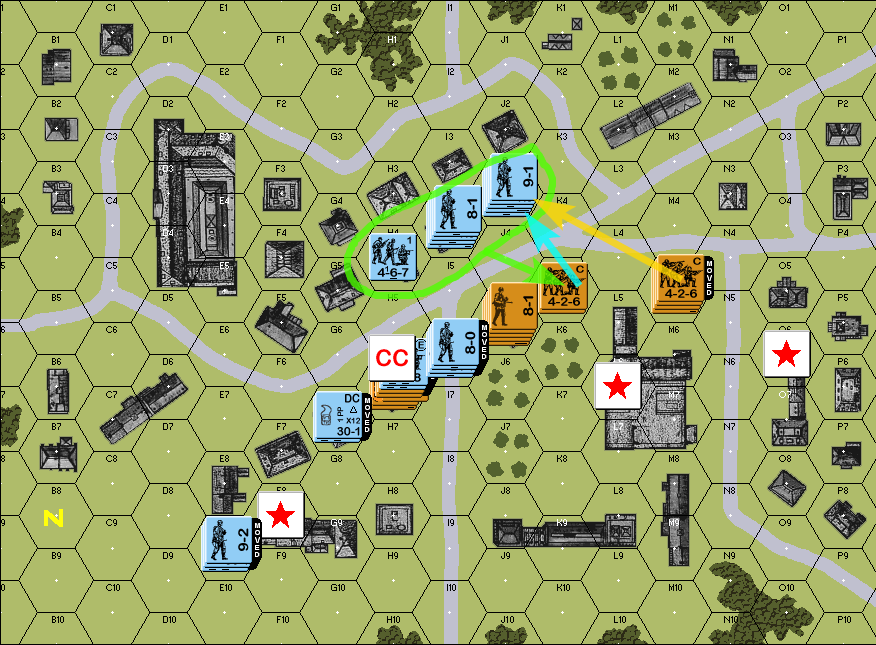 - green: during the Fire Phase, the squads in H4, I4, and J3 all form a big FG to shoot at the conscripts in K5, but they roll a 12 and accomplish nothing - yellow: during the Defensive Fire Phase, the stack in M5 shoots at J3, to no effect - teal: also during the DFP, the stack in K5 also shoots at J3, also to no effect Close Combat Phase 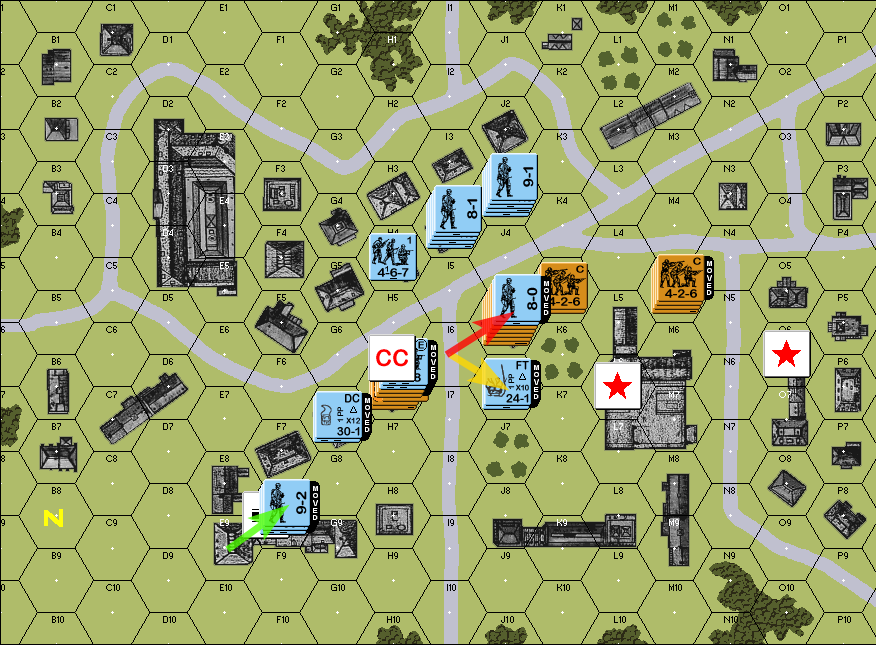 - green: the 548 and the 9-2 advance one hex to confirm securing the objective building - yellow: the 467 with the flamethrower advances to the orchard in J6 - red: the 467 and the 8-0 leader advances to Close Combat with the Soviet stack in J5 on to the close combat resolution: 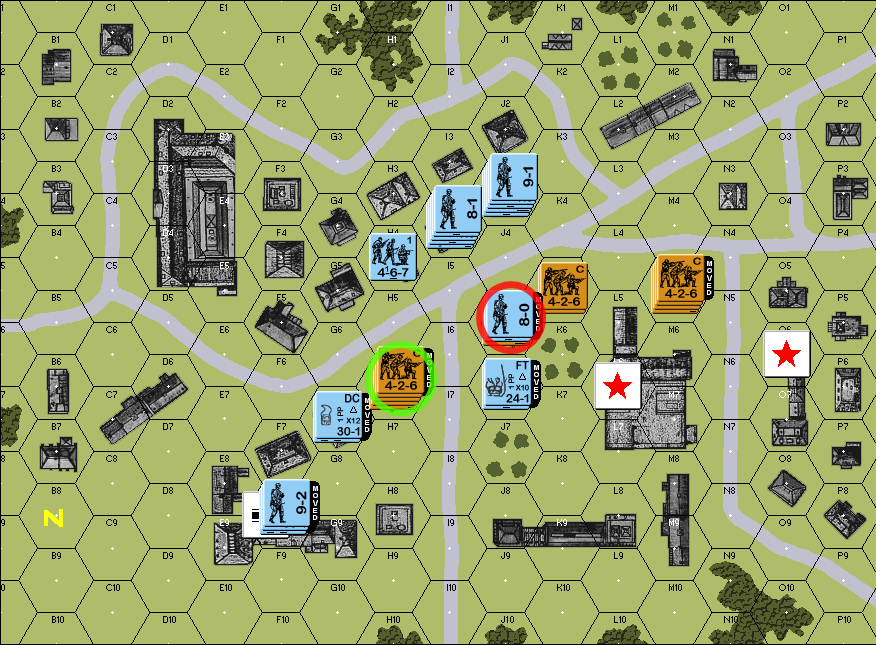 - green: the Soviets prevail here, eliminating the two German 548s - red: the Germans prevail here, eliminating the three Soviet 447s and the 8-1 leader quote:In retrospect, I could have run the red combat differently. The way I did it here, I didn't count the broken Soviet squads at all, leading it as a 1:5 / 5:1 odds CC. I reviewed the CC rules closer later in this scenario and found that I should have let the 447s have half of their FP when defending against the German attack (but still not counting when attacking). That might have shifted the odds enough to let the stack survive for another turn. End of German turn 2
|
|
|
|
Broken units defend at half? Bummer. Surprised you didnt just run into the objective bldg with the 6 movement points you had, tbh. Free bldg that instantly counts as yours once you move in, force hesitation when the Fussians try to move in, and a FT to roast anyone and everyone
|
|
|
|
for the life of me I couldn't remember why I made the FT squad pause in the orchard. I think I might have intended it to do a follow-up attack on K5, but in retrospect it seems like a poor move the way I'm doing this, where I'm playing through the scenario first, then doing the post and write-up after-the-fact, has an interesting vibe when I've been learning so much about the game in such a short time and I start to wonder "what was I thinking?" a week later EDIT: Jobbo, per straight-ASL, what is the procedure for an MMC attacking a Gun target with their inherent FP? It's going to be relevant to me very soon and I can't find anything about it. Given the lack of any specific reference, it seems like the answer is "it's just like if the squad was shooting at the crew of a gun". from the ASL-SK rulebook: 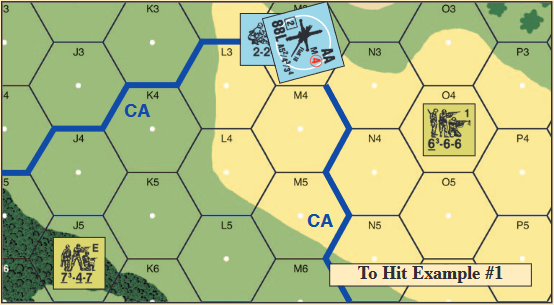 if the 6-6-6 in O4 wanted to attack the German 88, the thing they would actually be shooting at is the 2-2-8 crew, and it would be a plain 6 FP attack on the IFT with a +2 Hindrance DRM from firing across two grain hexes (if the grain is in-season)? my impression is that the gun itself offers no particular protection to the crew in terms of DRM, but the advantage is that guns have much longer ranges (the infantry might not ever be able to get into range even if the gun is in an Open hex), guns might be placed in hexes where they have cover, and guns might even be Hidden-In-Place gradenko_2000 fucked around with this message at 13:04 on Feb 26, 2024 |
|
|
|
Depending on the Gun and/or if it is Emplaced, it gets a +2 TEM DRM to the shot. Otherwise normal TEM. (You can't have both). The Grain shot is only +1. The rule states through, not into/out of a hindrance location. Smoke is handled differently.
|
|
|
|
Soviet turn 2 Rally Phase SSR reinforcements are supposed to enter the map on a roll of < the current turn. The Soviet player rolls a 5, which means no entry. Movement Phase 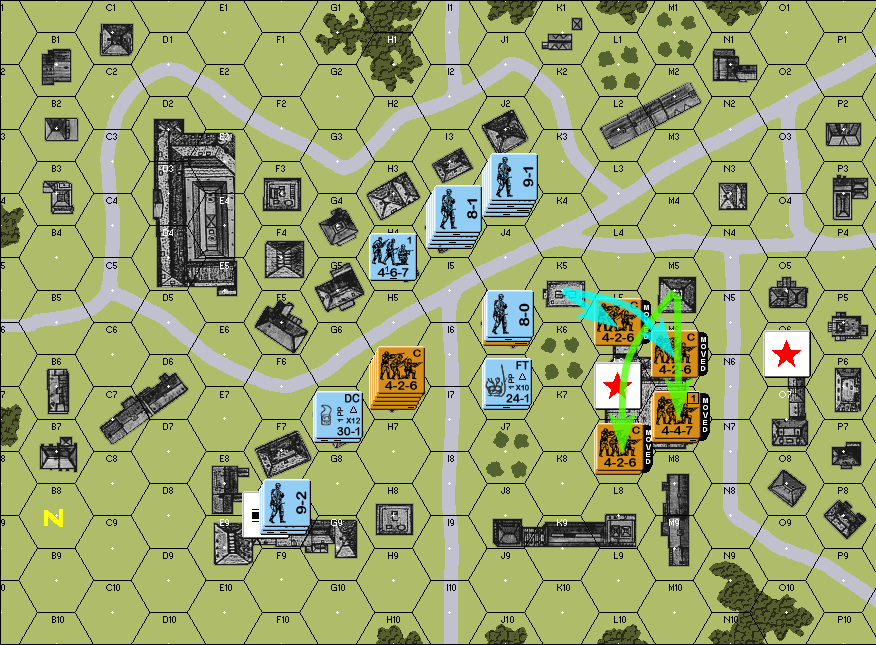 The four currently unengaged squads disperse across the central building objective. Fire Phase 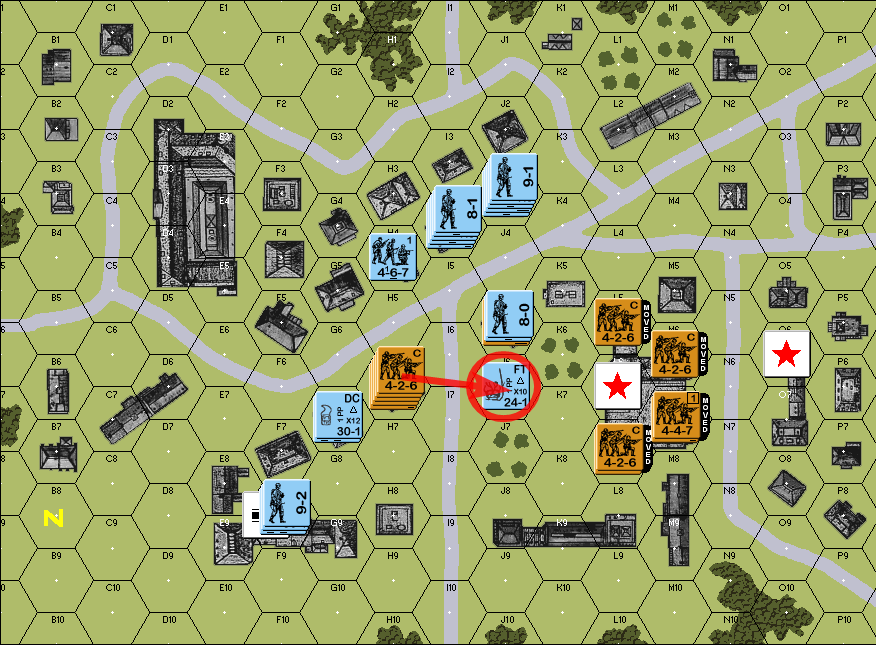 The stack in H6 fires a 16 FP attack against the flamethrower squad and rolls a 3, which eliminates the German unit completely. Defensive Fire Phase 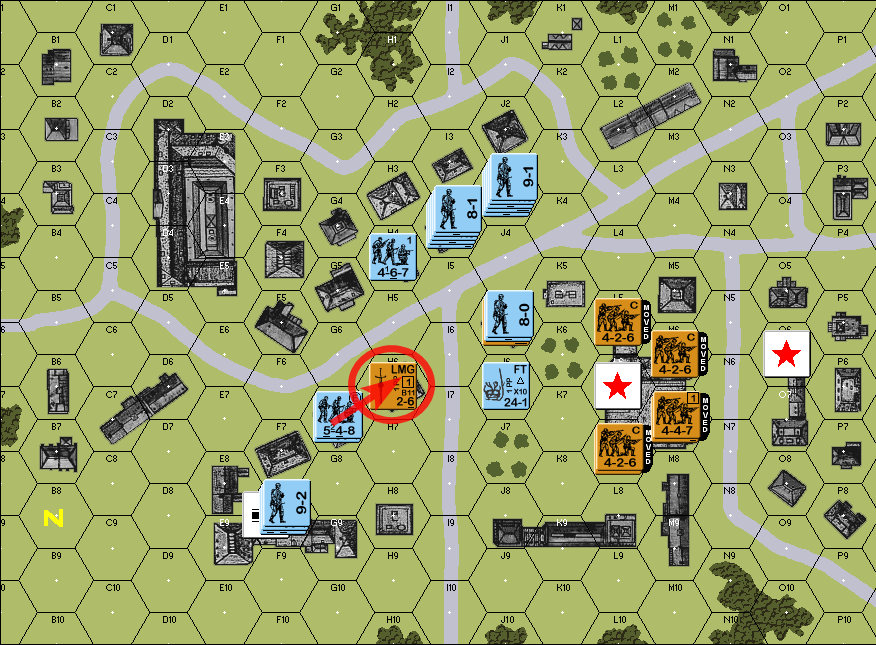 The one 548 in G7 makes a point-blank shot at the stack that just knocked out the flamethrower. The 548, with a 10 FP attack, rolls a 5 and cowers, but shifting over to the 6 FP column (from 8) still yields a "7" result, which breaks the whole stack (a 7 morale leader, a 7-morale 1st-line, and two 6-morale conscripts). When considering the rout, there's no place for the broken stack to go: G6, H5, I6, I7 and H7 are all both open hexes, and are within LOS and range of Good Order enemy squads, and so the whole stack is eliminated due to failure-to-rout. quote:This can feel a little extreme, though it's also the case that the Soviet units were in a particular situation where not only did the enemy surround them with sight-lines (the stack in F8 especially), but also that the hex they were in just happened to not have any kind of nearby cover available. The stack in J5 also shoots at the Soviet squad in L5, but to no effect. Close Combat Phase - no advances, no close combat End of Soviet turn 2 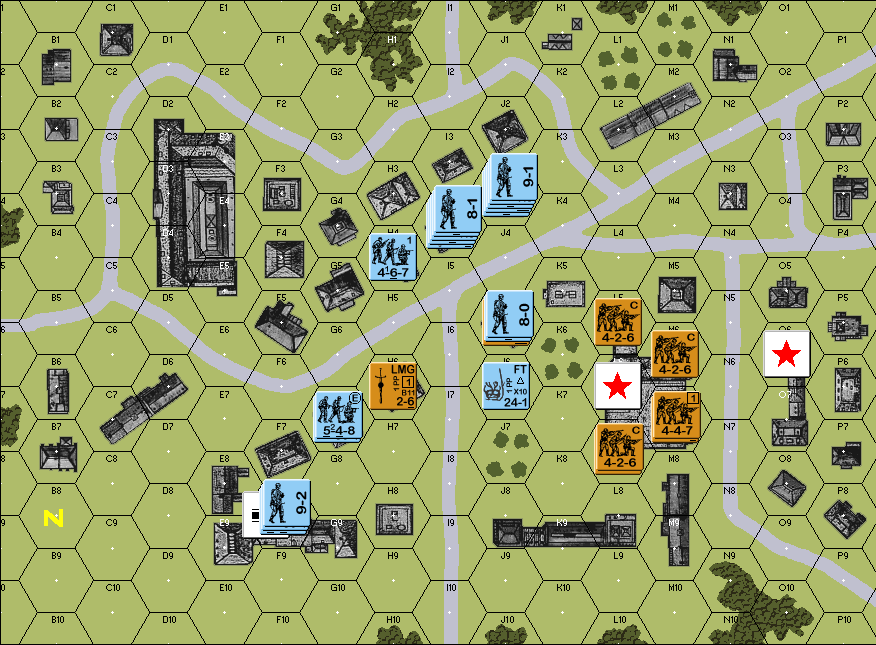
|
|
|
|
German Turn 3 Rally Phase of the two broken MGs still remaining, one gets repaired Movement Phase 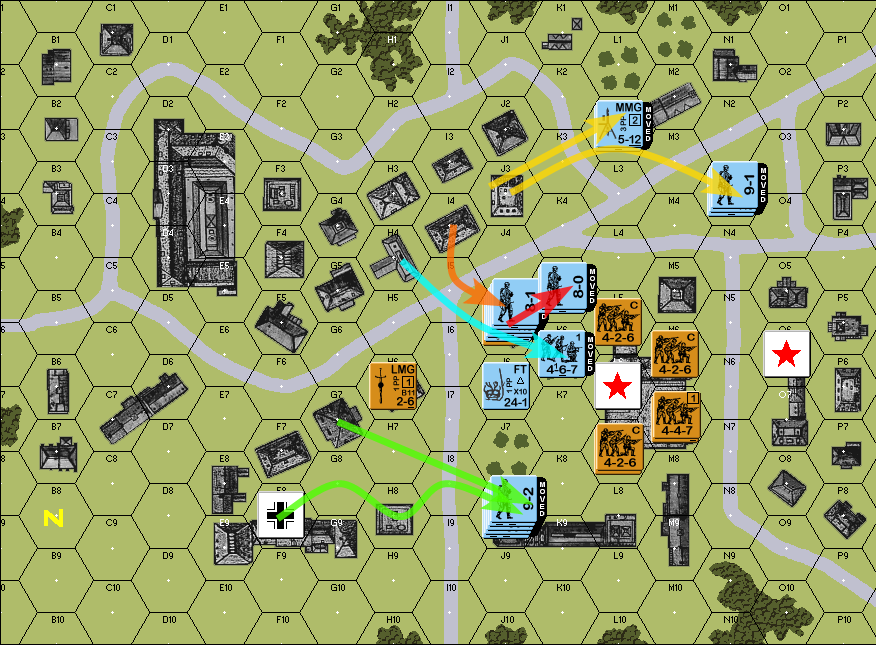 The Germans go all-in, trying to surround the factory building from all sides. - green: two 548's and the 9-2 leader combine to the south, looking to engage at L7 - red and teal: two more squads and another leader are aiming to break in along L5... - orange: ... with another two squads and a third leader right behind them - yellow: and the MG position at J3 breaks up to threaten the exposed right-hand objective Fire Phase - all German units moved, no fire Defensive Fire Phase 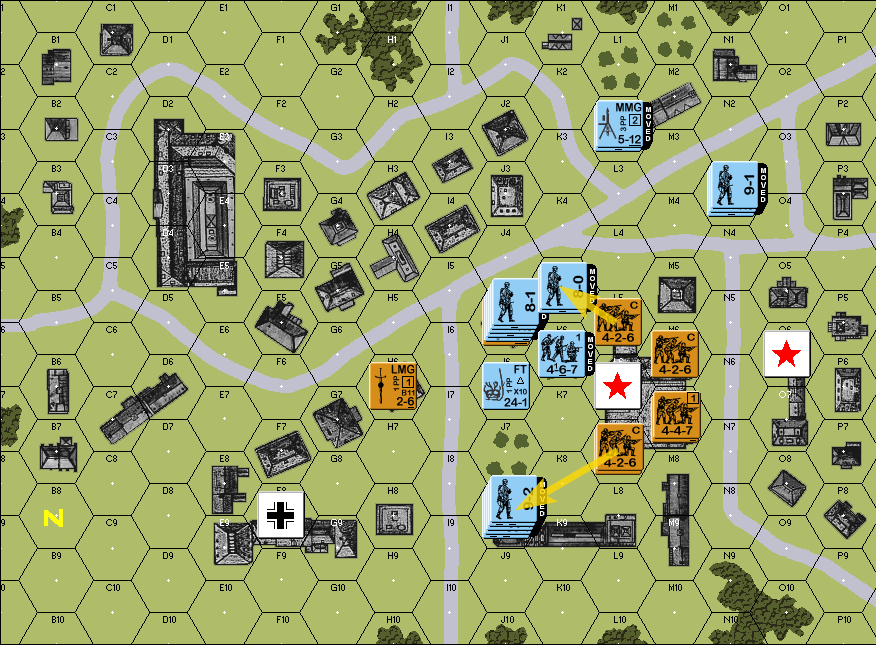 The Soviets attempt to fend off the approach, but the fire is desultory, and has no effect Close Combat Phase 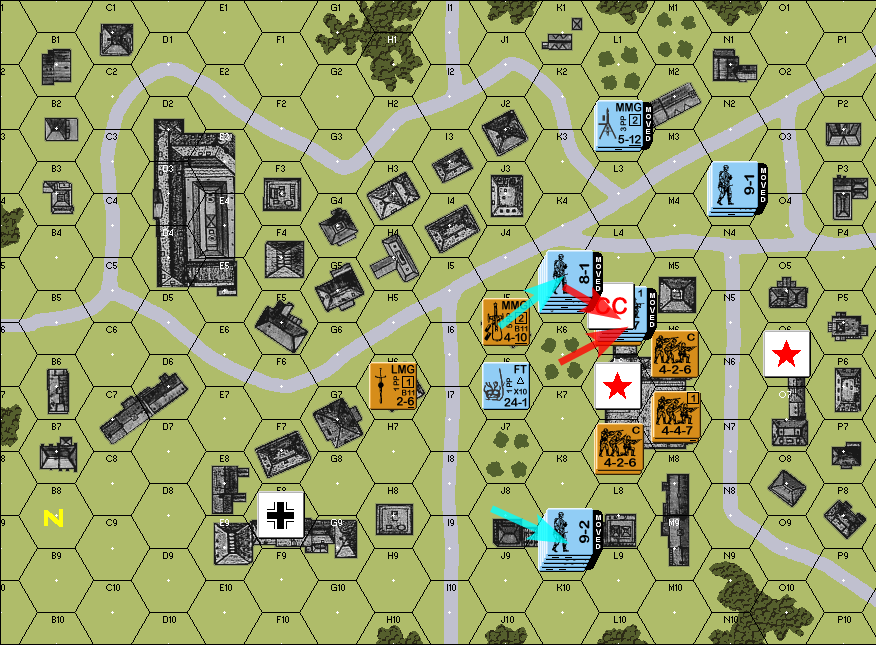 two German 467s and a leader close in on a single Soviet squad in L5, then the two other big stacks scoot closer Close Combat is rolled, and the Germans prevail, eliminating the Soviet 426 End of German turn 3 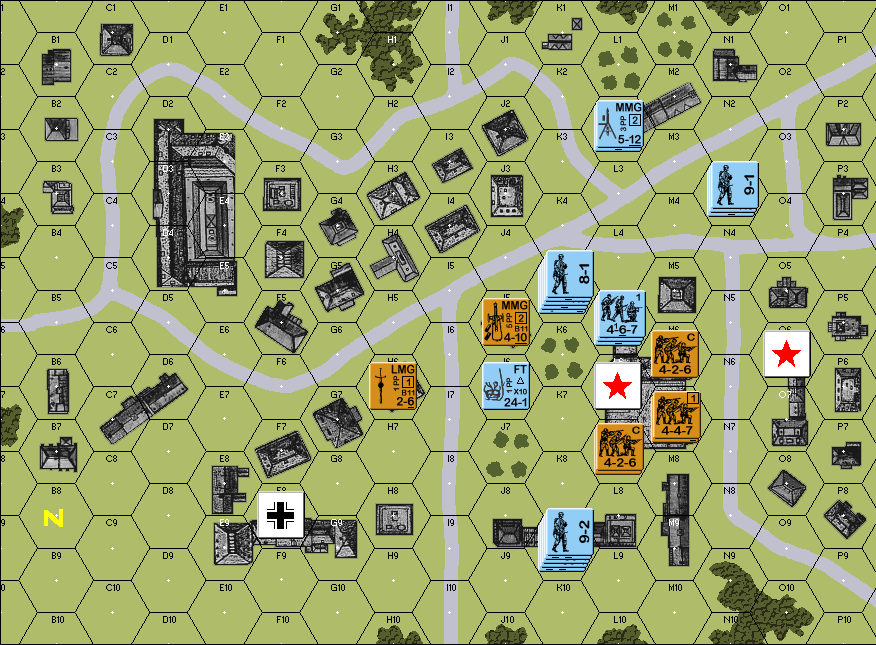 To be completely frank, this turn (and the ones that would follow) left a bad taste in my mouth. While Hesitation does teach you how you should move - look for non-open hexes, only cross open hexes when absolutely necessary, and have a plan for how to survive such a crossing, the way it's set up gives the attacker a LOT of freedom in being able to move almost without repercussions. Even if the Soviet 447 was in L6 or L7 to get a clearer shot at the Germans as they came in, the only Hesitation check would be at I8, and the 9-2 leader guarantees that they'd be able to pass the check anyway. I kept thinking that, under ASL, all of these units would at least have had to survive PBF and SFF and even FPF - and while the odds of such shots getting the stop the Germans might have been low, it wouldn't have been zero. Alternatively, Retro does have "optional rules" on how to remove guaranteed Hesitation, as well as for implementing Hesitation checks on all types of terrain, but then you start "running home to mama" anyway with increasing complexity.
|
|
|
|
There would've been far more shooting, especially at units outside of buildings, and those shots are far better for the defenders when the targets arent in stone buildings.
|
|
|
|
This system feel like it'd be better at doing Warhammer 40K with it's melee focus or something. This feels like all maneuver and no fire and it's just wrong.
|
|
|
|
If its any consolation, Retro, in the way I currently understand it thanks to this thread, essentially plays in the way that Sir John D Avalon Hill specifically opposed for Squad Leader, as it ignores shooting in the movement phase in exchange for the hesitation mechanic
|
|
|
|
Soviet Turn 3 The Soviets roll a 1 on their SSR reinforcement roll, so new units will enter the board on this turn. Movement Phase 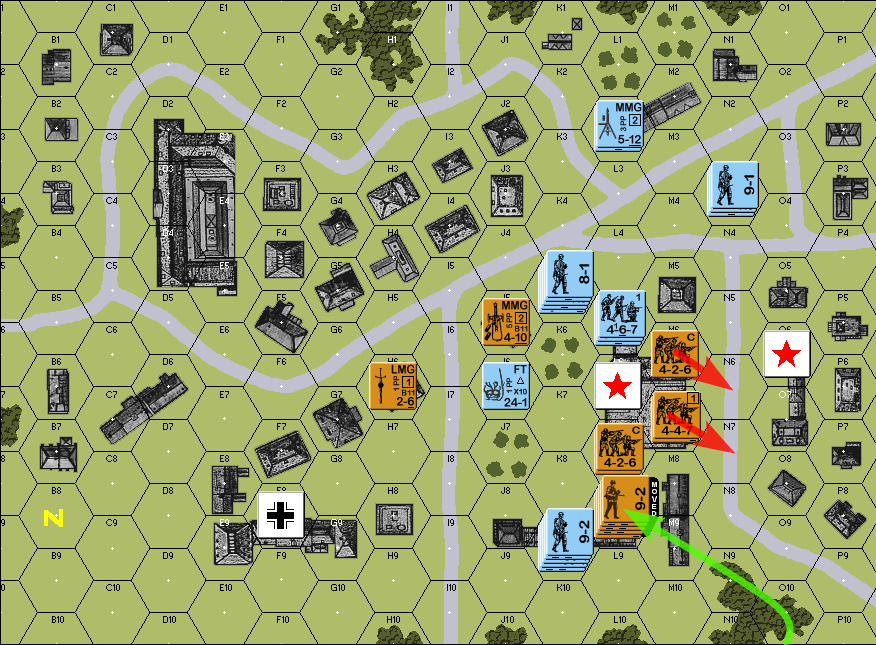 - green: the reinforcements arrive - three 1st-line 527 squads, an LMG, and a 9-2 leader. They move to L8 to prepare to engage the German elite stack coming up from the bottom - red: the 426 and 447 in the middle building attempt to reposition themselves, but the MMG in the N hexrow forces Hesitation checks, which they both fail when trying to cross the street Fire Phase - no fire done Defensive Fire Phase 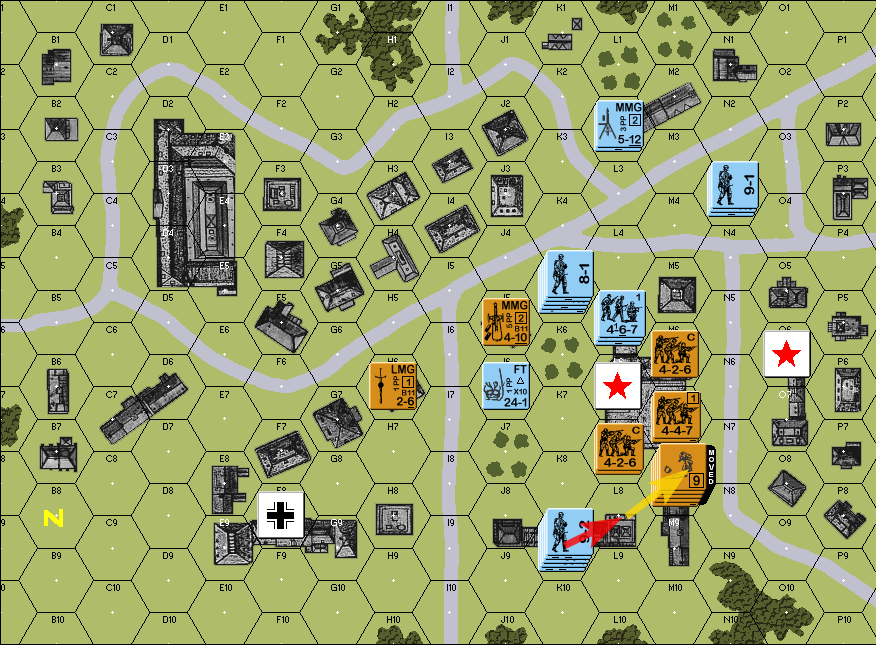 The German stack in K9 fires against the reinforcement group - they roll really well, getting a 5, which breaks the whole Soviet stack and gets them to rout quote:The game was already turning against the Soviets pretty bad before, but this right here sealed their fate. Very difficult to come back from this. Close Combat Phase - no actions taken End of Soviet turn 3
|
|
|
|
I know there's only like, two of you reading this thread rn, but we're almost done with this scenario, and I've got some follow-up material planned, but I'd like to ask which one you'd like to see (first): - another playthrough of this scenario, War of the Rats, still in Retro, but with tougher Hesitation rules: 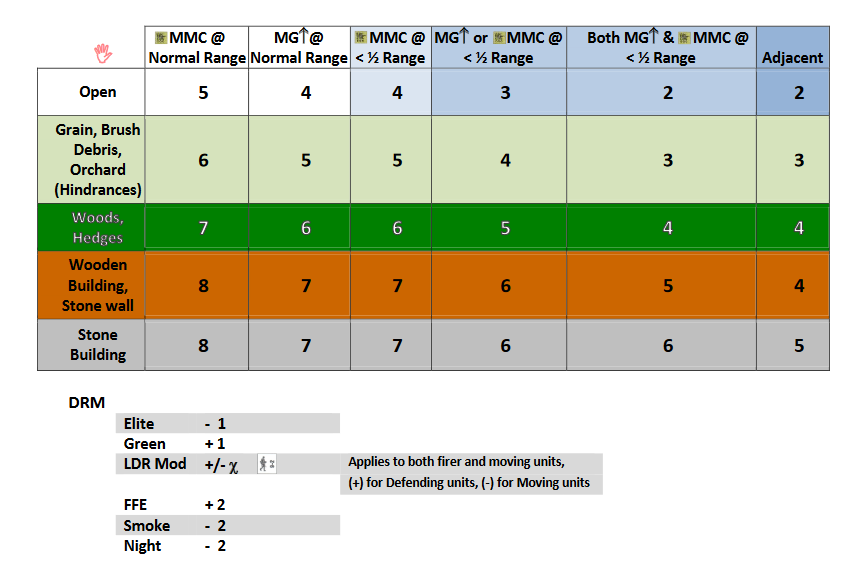 - a new scenario, played in straight ASL-SK rules, with an eye towards providing color commentary that contrasts it against our current experience
|
|
|
|
ASL is my thing, how dare you.
|
|
|
|
I’d like to see the tougher hesitation rules first! Also thanks for this thread, it’s cool seeing the game being played step by step
|
|
|
|
Enjoy watching these games. Never done squad based hex stuff, so enjoyable to see how different ones play
|
|
|
|
German Turn 4 Rally Phase The Germans still have two broken MGs - they roll to repair, but to no effect Movement Phase 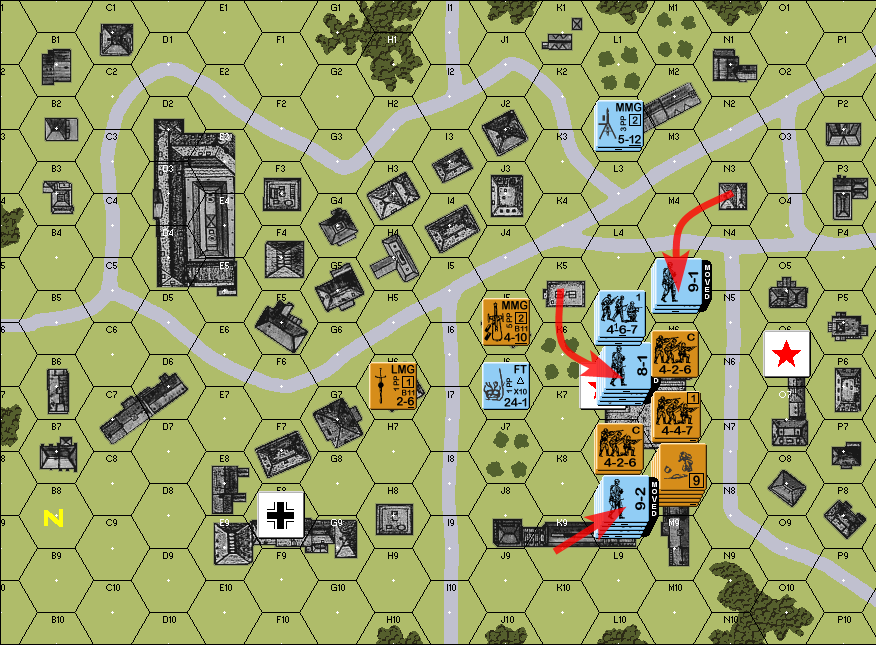 the three big German stacks move in to contest the middle building Fire Phase - no fire done Defensive Fire Phase 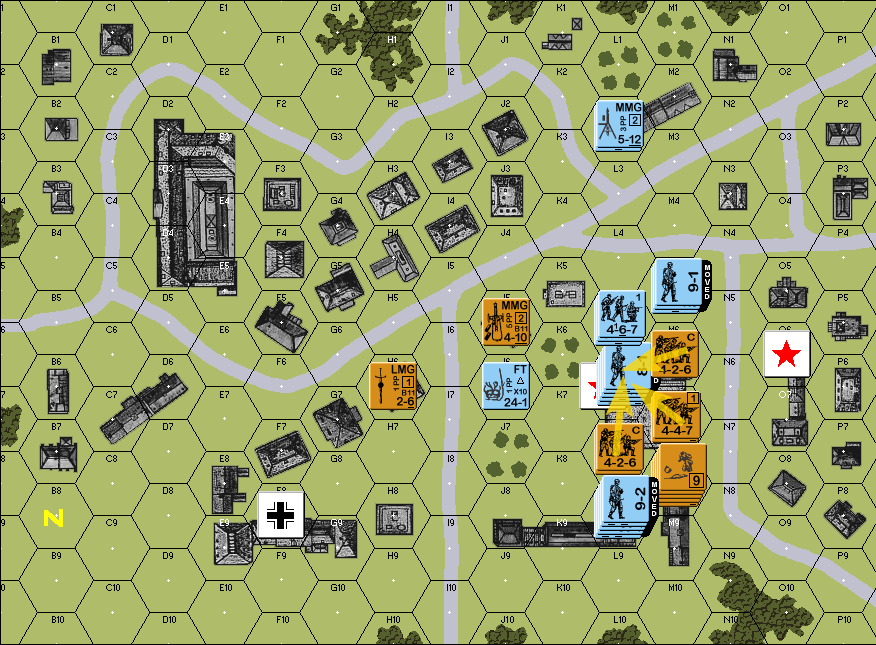 the Soviets drop a 28 FP fire group on the big stack, but they roll a 13 and accomplish nothing Close Combat Phase 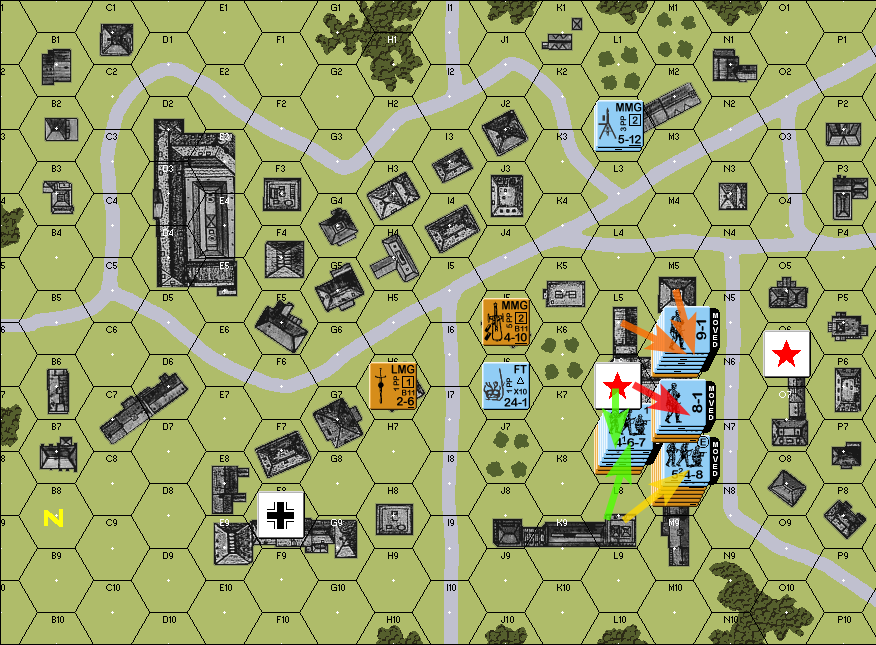 - yellow: a single 548 engages the broken stack in M8 - green: a 548 and the 9-2 leader from L8, and a 467 from L6, engages the Soviet stack in L7. That's a Soviet 426 and an 8-0 leader defending - red: a 467 and an 8-1 leader, the other half of the stack from L6, engages the Soviet 447 in M7 - orange: finally, the two German stacks from L5 and M5 converge on M6. That's a single Soviet 426 defending against three 467s and a 9-1 leader resolving all the Close Combats: quote:Close combat in M6 This is what the map looks like at the end of the German turn:  The scenario is effectively over at this point: the Soviet stacks are locked in melee, and nothing happens on the Soviet turn except re-rolling for the two remaining Close Combats. Assuming they survive, on the next German turn, L7 gets dogpiled further. As long as L7 gets eliminated, then the broken stack in M8 never gets to recover/rally and is guaranteed to be eliminated As I'd mentioned previously, I wasn't particularly happy with how this scenario played. Not that I was rooting for one side in particular, but rather that there didn't seem to be a lot of tactical choice besides bumrushing the Soviets because the German elite squads can pass the single hex of Hesitation. That said, I think the next scenario is going to be a bit more interesting, so stay tuned!
|
|
|
|
War of the Rats suffers from not being a complex scenario, too
|
|
|
|
Jobbo_Fett posted:War of the Rats suffers from not being a complex scenario, too I do think this is also a factor, yes - the Germans can start the game already right up next to the Soviets, with no ingress required save the final street crossing, and they're given a ton of heavy weaponry, and the variability of the arrival of the Soviet reinforcements can screw the Reds over big-time after spending some more time with the system over the past week, I'm trying to not be so negative as I might have come off as, as I think WOTR's idiosyncrasies might not make it a particularly good vehicle to evaluate Retro's rules
|
|
|
|
gradenko_2000 posted:I do think this is also a factor, yes - the Germans can start the game already right up next to the Soviets, with no ingress required save the final street crossing, and they're given a ton of heavy weaponry, and the variability of the arrival of the Soviet reinforcements can screw the Reds over big-time Of all the recorded plays on ROAR/ASLSA, the WOTR results stand at 275/269/3 for the German/Russian/Draw wins. Its a super balanced scenario, one designed to get you to understand assaulting tough urban defenses, but super one note. If anything, I think its a great way to show off Retro's differences from ASL and, in some cases, ASLSK
|
|
|
|

|
| # ? Apr 28, 2024 16:41 |
|
huh, that's fascinating. Maybe I should look around and see if there are any after-action reports to see how other people have "beat" it, from either side
|
|
|










